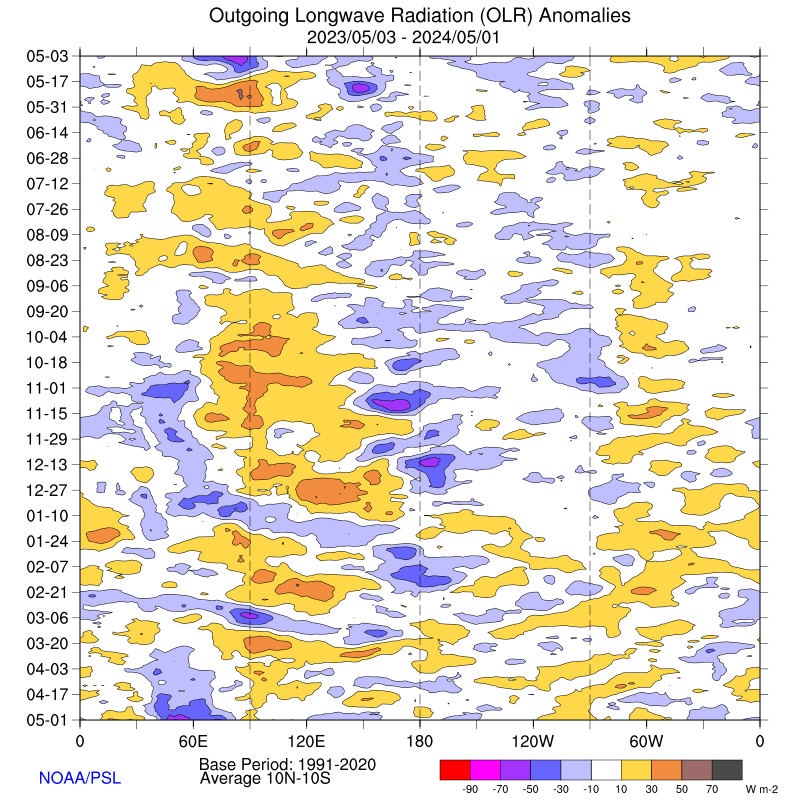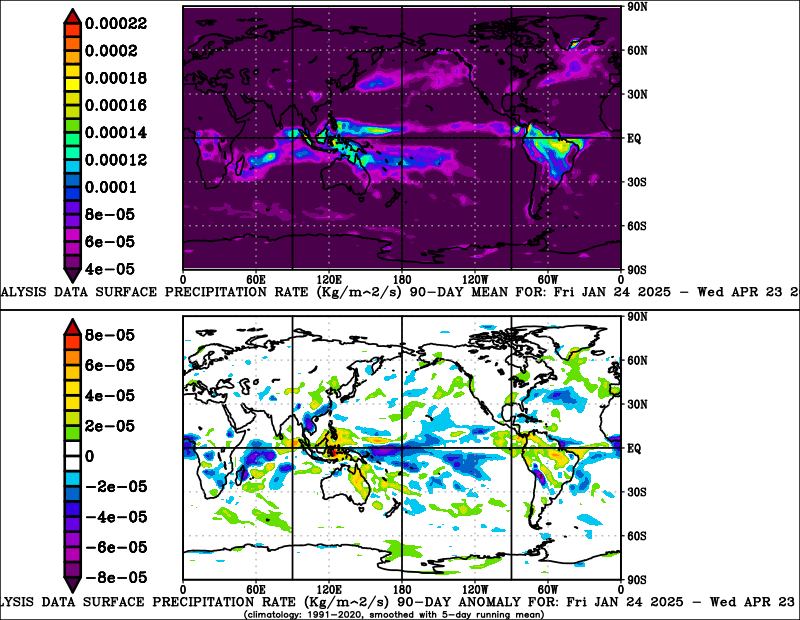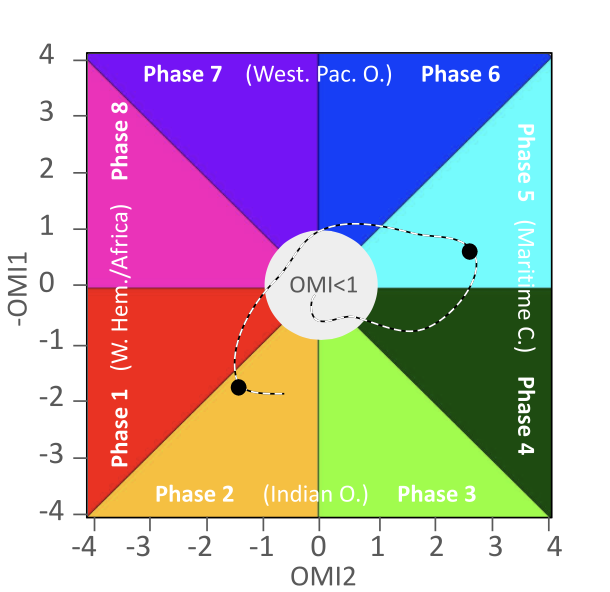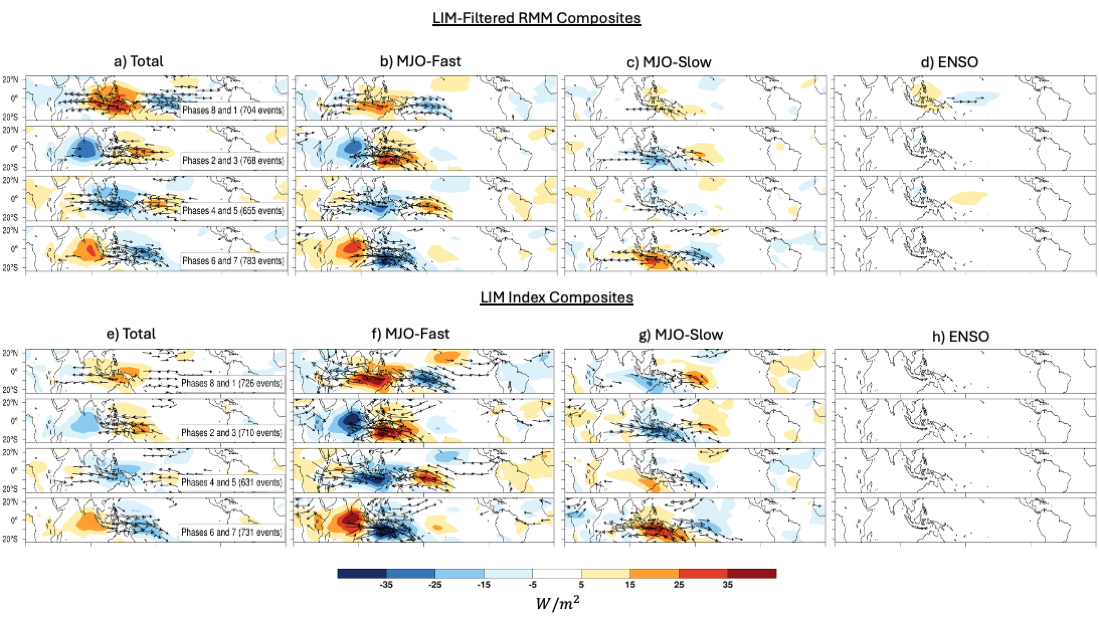Madden-Julian Oscillation (MJO)

MJO Overview
The Madden-Julian Oscillation, often referred to as the MJO, is a mode of sub-seasonal atmospheric variability that influences the location and strength of tropical precipitation. It is an eastward moving disturbance of clouds, rainfall, winds, and pressure that traverses the planet in the tropics and returns to its initial starting point in 30 to 60 days, on average.
The MJO impacts extreme weather around the globe. MJO-related weather effects on the United States specifically include extreme rainfall on the west coast related to Atmospheric Rivers as well as hurricane landfalls in the Southeast. These events can have a significant impact on communities, property, and livelihoods. It is NOAA's mission to provide early warning to strengthen the nation's ability to prepare and protect against the damages from extreme weather events.
PSL research aims to better understand, model and predict the MJO and its impacts.
More about the MJO
The MJO was first described in 1971 but a field project held over the west equatorial Pacific during 1992-93 raised awareness of the MJO as a coherent phenomenon, possibly useful for weekly predictions of tropical precipitation and extratropical weather patterns. The MJO is best defined over the oceanic warm pool, which extends from the Indian Ocean to the central Pacific and where complex variations of precipitation occur from day to day. The warm pool is generally defined by sea surface temperatures that are above 28C.
PSL's MJO research focuses on:
- understanding multi-scale processes that impact the strength of the MJO,
- improving weather model's representation of the MJO,
- developing methods to identify the MJO, and
- identifying MJO remote weather impacts over the Western United States.
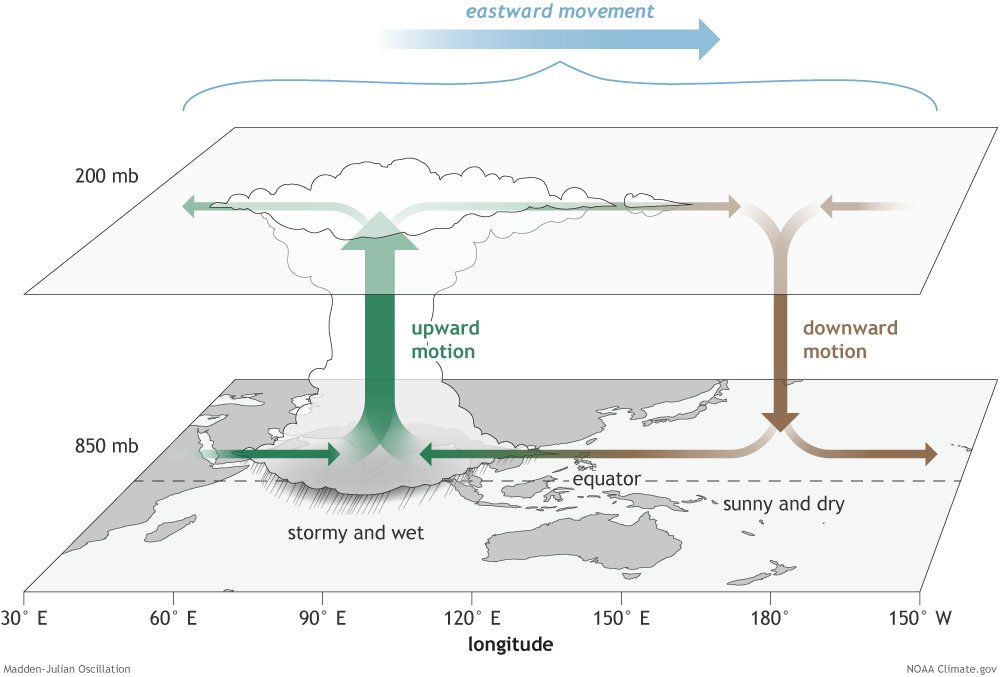

Current Status of the MJO
Phase Diagrams
ROMI phase diagram for the latest 90 days
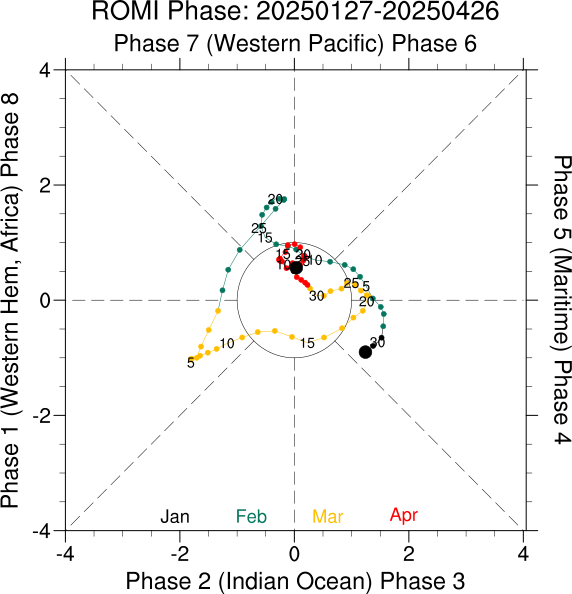
RMM phase diagram for the latest 90 days

VPM phase diagram for the latest 90 days
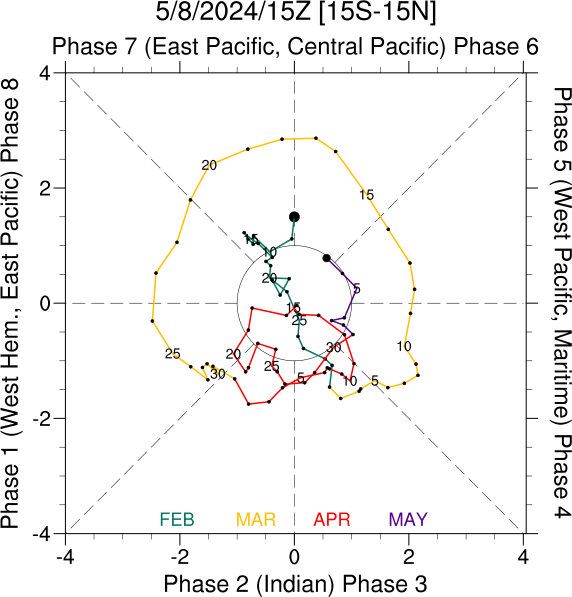
rMII phase diagram for the latest 90 days
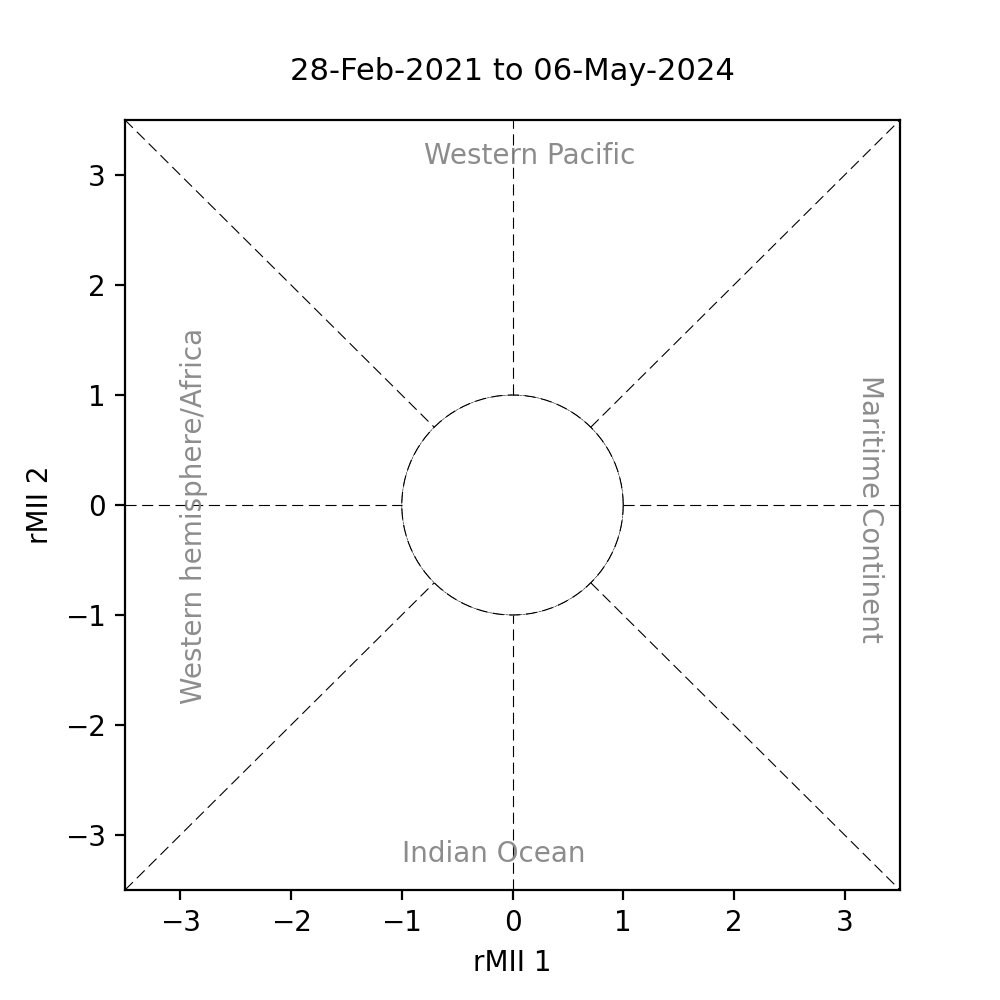
Atmosphere
Satellite
MJO Indices
PSL is creating a set of MJO timeseries that quantify current and historic MJO activity. Links and descriptions are below as well as links to some other MJO timeseries created at other institutions. A description of the timeseries format is available.
Daily MJO index time series from 1979
| Index | Description | Obtain timeseries |
|---|---|---|
| ROMI The Real-time OLR MJO Index |
Projection of 9 day running average OLR anomalies onto the daily spatial EOF patterns of 30-96 day eastward filtered OLR. OLR anomalies are calculated by first subtracting the previous 40 day mean OLR. The running average is tapered as the target date is approached. | ROMI values |
| RMII The Realtime Multivariate Index for tropical Intraseasonal oscillations |
Projection of 9 day running average anomalies onto the daily spatial multivariate EOFs of 20-96 day eastward filtered OLR, U850 and U200. Anomalies are calculated by first subtracting the previous 40 day mean. The running average is tapered as the target date is approached. | rMII data currently unavailable. We are working on having this back on the website in the near future. |
| Index | Description | Obtain timeseries |
|---|---|---|
| RMM* The The Realtime Multivariate Madden Julian Index* |
Calculated the same way as the Wheeler-Hendon RMM, but instead of subtracting off the mean of the previous 120 days, a filter based on a linear inverse model (LIM) is applied to remove ENSO variability before projection onto the RMM EOFs. See Marsico et. al. 2025 for further details regarding the LIM filter. The data covers November 1st through April 30th from 1979 to 2021. The file contains all dates with the summer values set to missing. | RMM* values New! |
| OOMI The Original OLR MJO Index |
Projection of 30-96 day eastward only filtered OLR onto the spatial EOF patterns of 30-96 day eastward filtered OLR. This results in a smoother index than OMI due to more restrictive filtering. | OOMI values |
| OMI The OLR MJO Index |
Projection of 20-96 day filtered OLR, including all eastward and westward wave numbers onto the daily spatial EOF patterns of 30-96 day eastward filtered OLR. | OMI values |
| FMO The Filtered OLR MJO index. |
Univariate EOF of normalized 20-96 day filtered OLR averaged from 15S-15N, by longitude. The same spatial EOF pattern is used for the entire year (see below). | FMO values. |
| ERA5 OMI The ERA5 OLR MJO Index |
Projection of 20-96 day filtered ERA5 OLR, including all eastward and westward wave numbers onto the daily spatial EOF patterns of 30-96 day eastward filtered OLR from the ERA5 dataset. EOFs are calculated using data from 1940 to "present". | ERA5 OMI values |
| VPM The Velocity Potential MJO index. |
Calculated in the same way as the Wheeler-Hendon RMM, except using 200 hPa Velocity Potential instead of OLR, along with U200 and U850 in a combined EOF (see link to Ventrice et al. 2013 below). | VPM values |
| REOMI The Rotated EOFs OLR Madden Julian Index. |
Projection of 20-96 day filtered OLR, including all eastward and westward wave numbers onto the rotated daily spatial EOF patterns of 30-96 day eastward filtered OLR. EOFs are calculated using OLR from 1979-2012. PCs are calculated from 1979-2022. EOFs are rotated to reduce noise and potential degeneracy issues as detailed in Weidman et al., 2022. | REOMI values |
| KRMM The Koopman Real-time MultiVariate Madden Julian Index |
Calculated following the Wheeler-Hendon RMM, but using Koopman spectral analysis to compute eigenfunctions. The leading mode of intraseasonal variability is rotated to maximize correlation with the standard RMM. See link to Lintner et al. 2023 for further discussion of the Koopman spectral analysis and methodological details. | KRMM values |
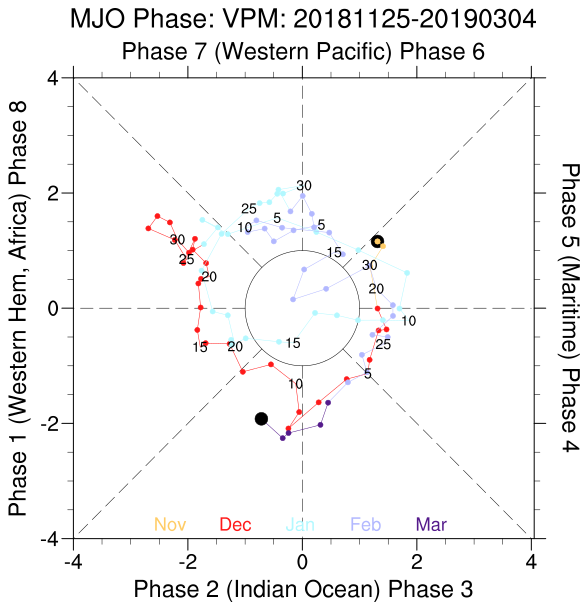
|
MJO Indices Phase Diagram
Tool 
Plot phase diagrams of selected MJO indices. |
Other MJO indices
- The All-season Real-time Multivariate (RMM) MJO Index (Wheeler-Hendon) from the The Centre for Australian Weather and Climate Research .
- Bimodal ISO Index for historical data analysis and real time monitoring from the International Pacific Research Center.
- Carl Schreck's analysis of the RMM components .
Click on each section below to expand/collapse
Code
A python routine to calculate the OMI has been developed for use on real-time and model
data,
and
can be accessed via GitHub at: https://github.com/cghoffmann/mjoindices and also at Zenodo: https://doi.org/10.5281/zenodo.3613752.
For the REOMI, code is in the same repository. using the parameter
eofs_postprocessing_type="eof_rotation" in the main method for calculating EOFs:
omi.omi_calculator.calc_eofs_from_olr(). No other changes should be necessary from the
standard
OMI calculation.
Details of the implementation of this software as well as the ERA5 based OMI computation
Python
package are outlined in this article:
The EOFs for the ERA5 based OMI were computed using data from 1940-2023. Using the years 1979-2018 to compute ERA5 EOFs gives good agreement with the observed OMI EOFs in terms of spatial correlation (see below). The EOFs for the time period 1940-2023 have less agreement, but still a pattern correlation above 0.9 for most of the year.
The rMII code and MII values are available upon request from the lead author Shuguang Wang .
Python routines to calculate OMI:
MATLAB routines to calculate KRMM:
- Courtesy of Dimitrios Giannakis at https://github.com/dg227/NLSA/tree/master/pubs/LintnerEtAl23_GRL
Citations
For more information for all indices other than the VPM and rMII, please read the article A comparison of OLR and circulation based indices for tracking the MJO .
If you use the timeseries in your research, please cite that paper, e.g.:Composite Patterns
Composite streamfunction and OLR patterns for RMM and OMI based on the events that exceed 1 standard deviation for each phase of the PC combination.
These are based on data from 1979 through 2012, and the number of events in each composite is given as "N= " at the bottom of each plot. Blue shading denotes negative OLR anomalies (regions of convection) and red positive (suppressed), with two levels of shading at +- 10 and +- 6 W/m**2. Streamfunction contour interval is 5 X 10**5 m**2/s at 200 hPa, and 2 X 10**5 m**2/s at 850 hPa. To facilitate comparison with RMM, these composites are constructed by reversing the sign of OMI PC1 and the OMI PC ordering, so that OMI(PC2) is analogous to RMM(PC1) and -OMI(PC1) is analogous to RMM(PC2), as described in Kiladis et al. 2014.
Other
MJO EOF Patterns
OMI EOF Patterns
- The ASCII EOF values are available via ftp/downloads for EOF1 and EOF2 . They can be read using the code read.eof.f. User can retrieve the files via the web or using an (anonymous) ftp client at the address ftp2.psl.noaa.gov. Then, cd to /Datasets.other/MJO/.
OMI EOF Animations
- An animation
of
the
daily OMI EOF's (realtime player format).
- A javascript animation of the daily OMI EOF's.
VPM EOF Patterns
- The VPM EOFs are computed using zonal wind and velocity potential based on NCEP
reanalysis
version 1 from 1979 to 2012.
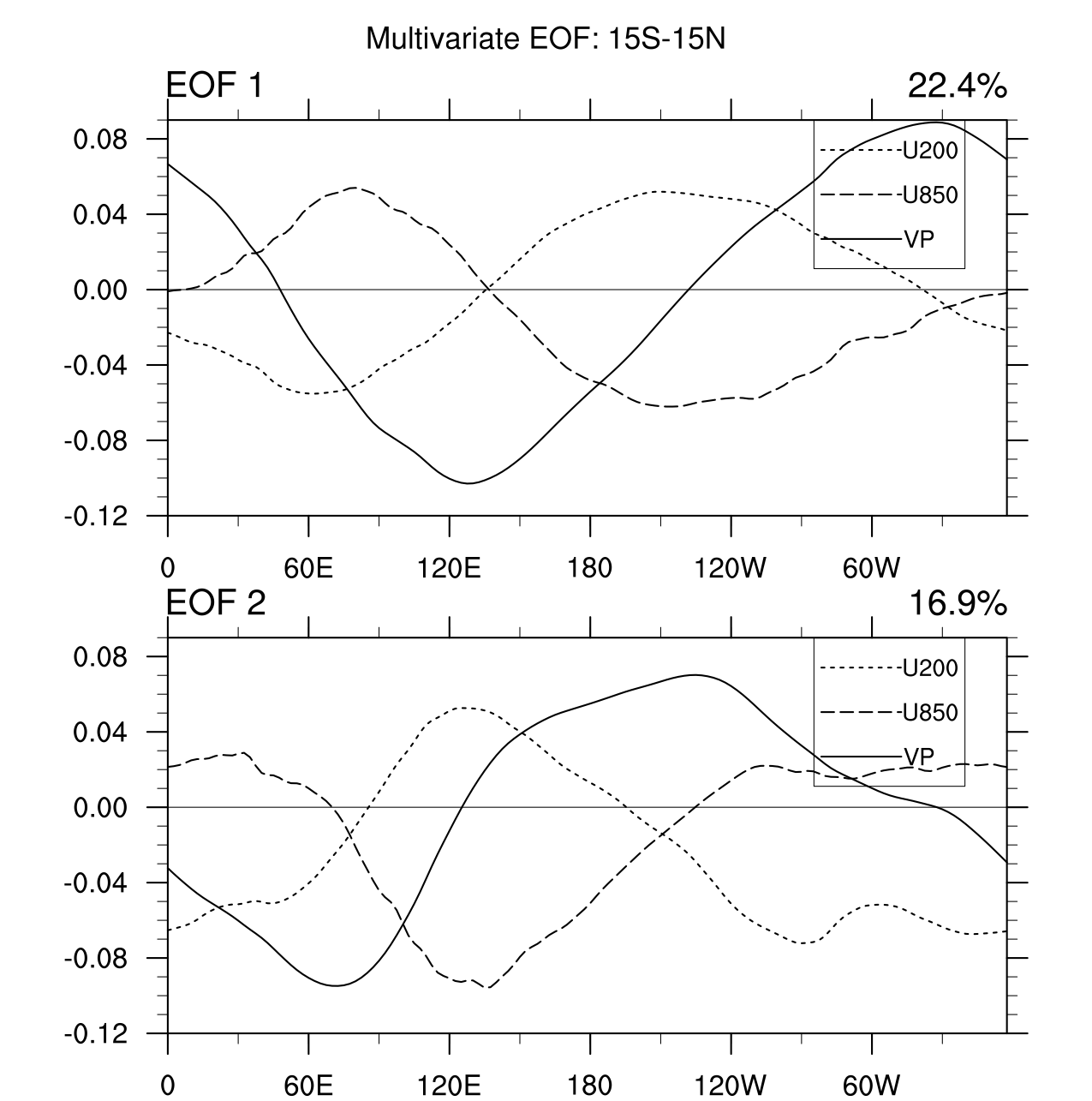
FMO EOF Patterns
- The ASCII FMO EOF values are available from here.
FMO Spatial EOFs 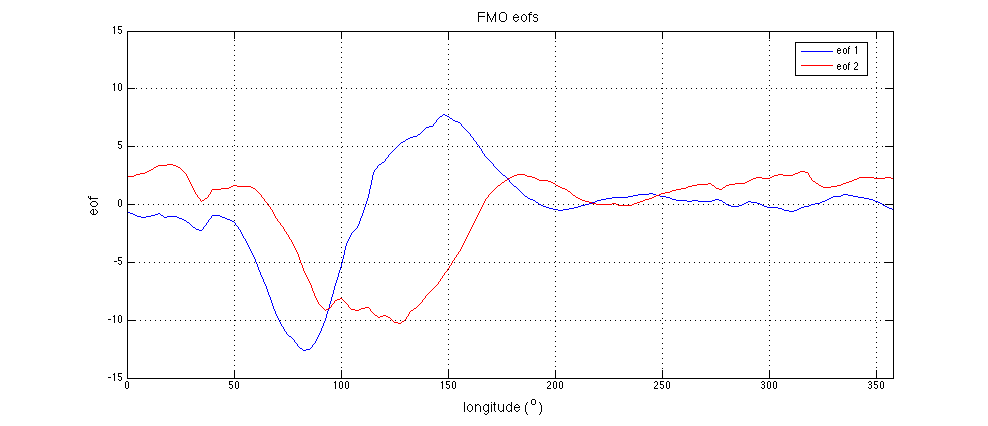
Comparison of OMI EOFs from ERA5 vs Observed OLR
Pattern correlation between observed OMI EOFs from 1979-2012 and ERA5 OMI EOFs from 1979-2018 for each day of the year. EOF patterns are correlated at 0.95 or above and PC time series are correlated at above 0.97 and are deemed sufficiently similar. The ERA5 based OMI was computed using the python package by: Hoffmann CG, Kiladis GN, Gehne M, von Savigny C 2021 A Python Package to Calculate the OLR-Based Index of the Madden-Julian-Oscillation (OMI) in Climate Science and Weather Forecasting. Journal of Open Research Software, 9:9. DOI: https://doi.org/10.5334/jors.331/ .
MJO Historical Events
MJO DJF Events Tabled
The ERA5 OLR MJO Index (ERA5 OMI) is used to identify historical MJO events from 1940 to 2023. An MJO event is defined as times when OMI amplitude local maxima within a centered 30 day period that also exceeds one standard deviation (as illustrated in the schematic below). Note: Dias et al. 2025 discusses the use of ERA5 to characterize the MJO during the pre-satellite period . Tables with OMI events by phase can be found below.
Table Guide
- Column 1: Event date as defined as OMI local max.
- Column 2 and 3: OMI PC1 and PC2.
- Column 4: OMI amplitude.
- Column 5: OMI phase (rotated to be consistent with RMM).
- Column 6: Days to demise (number of days subsequent to the OMI peak until OMI<1).
- Column 7: OMI phase at the demise lag.
- Column 8: Nino 3.4
- Column 9: QBO index (based on NCEP equatorial zonal winds at 50 hPa).
Use the dropdown below to select a phase and display the corresponding table:
Schematics
Fig.1 Schematic of MJO events definition based on ERA5 OMI
Fig. 2: Yearly count of MJO events occurring from December through February. Colors correspond to the OMI phase.
MJO Research at PSL
Robust Multi-Decadal Variability of Madden-Julian Oscillation Amplitude in the 20th Century
Understanding long-term variability in the Madden-Julian Oscillation (MJO) is crucial for improving sub-seasonal to seasonal predictions around the globe. Observations show that the MJO undergoes multi-decadal variability, with a robust increase in amplitude from the 1960s to the 1990s, followed by a decline in recent decades. In contrast, MJO behavior before 1960 remains more uncertain due to sparse and infrequent tropical observations, limiting our ability to clearly identify its characteristics.
More information in:
Dias, J., Gehne, M., Kiladis, G. N., Wolding, B., & Hoell, A. (2025). Robust multi-decadal variability of
Madden-Julian oscillation amplitude in the 20th century. Geophysical Research Letters, 52, e2024GL113303. https://doi.org/10.1029/2024GL113303
Impacts of Tropical Forecast Errors on Weeks 3–4 Extreme Precipitation Predictions over California during Winter 2022–2023
Accurately predicting extreme precipitation events weeks in advance is crucial for mitigating their destructive impacts and managing water resources. During the winter of 2022–23, multiple extreme precipitation events in California caused severe flooding while also alleviating statewide drought conditions. To improve subseasonal (weeks 3–4) predictions of such events, we conduct model forecast experiments examining the influence of tropical errors. By correcting these errors through nudging to reanalysis, we achieve significant improvements in the precipitation predictions over California compared to free-running control forecasts. Our findings highlight strong impacts of tropical errors associated with the MJO and transient synoptic-scale features on these predictions.
More information in:
Moore, B. J., J. Dias. A. Hoell, S. N. Tulich, M. Gehne, J. Albers, C. F. Baggett, and E. LaJoie, 2024:
Impacts of tropical forecast errors on weeks 3–4 extreme precipitation predictions over California during
winter 2022–2023., in preparation.

(a) Percentile rank of the observed accumulated precipitation for 30 December 2022 – 13 January 2023 in the 1994–2023 climatology. Ensemble forecast probabilities (%) of accumulated precipitation for 30 December 2022 – 13 January 2023 (days +15–29) exceeding the 80th percentile of the 1994–2023 reforecast-based climatology for (b) the control forecast and (c) the forecast with tropical nudging initialized on 15 December 2022.
The Crucial Role of the Initial State in MJO Prediction
MJO forecast skill is highly sensitive to initial conditions. Using NOAA’s Unified Forecast System, we show that model runs initialized with two independent reanalyses produce significant and persistent differences in MJO-circulation amplitude over 15 days. These differences are linked to initial atmospheric static stability, with less stable conditions enhancing vertical motion and divergent winds. However, a convection-based MJO index shows minimal sensitivity, suggesting that convection and diabatic heating are not the primary drivers of these forecast variations.
More information in:
Bengtsson, L., S. Tulich, J. Dias, B. Wolding, K. Hall, M. Gehene, G. Kiladis, P. Pegion, (2025): The crucial role of initial conditions in MJO prediction. Geophysical Research Letters., 52, e2025GL115833. https://doi.org/10.1029/2025GL115833
PSL News article - In brief: The crucial role of the initial state in MJO prediction
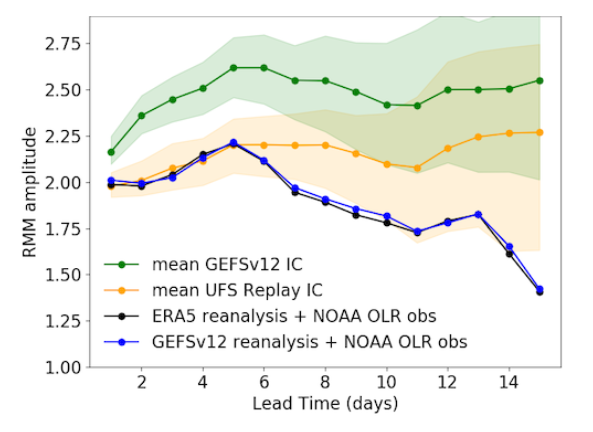
Real-Time Multivariate MJO Index (RMM) for UFS simulations initialized from UFS Replay (orange) and GEFSv12 reanalysis (green). The blue and black curves represent observations and/or reanalysis. Shading represents the ensemble difference between the minimum and maximum ensemble for each time. UFS simulations initialized from GEFSv12 reanalysis have a larger amplitude throughout the whole forecast, attributed to a more statically unstable initial state.
Plume Model Assessment of Systematic Errors in Tropical Convective Coupling in the NOAA Unified Forecast System
Accurate representation of tropical convection is essential for improving subseasonal-to-seasonal forecasts, as errors in convective processes can disrupt global weather patterns. We examine the rapid development of systematic errors in NOAA’s Unified Forecast System representation of tropical convection using a plume model, which simulates the interactions between clouds and their surrounding environment. We find that the UFS has systematic errors in the representation of two key cloud types; congestus clouds and mesoscale convective systems. These errors negatively impact teleconnections to higher latitudes, which are crucial for predicting precipitation and temperature over the United States.
More information in:
Maithel, V., B. Wolding,, S. Tulich, M. Gehne, J. Dias, X. Quan, P. Pegion, L. Bengtsson (2025): Plume
Model Assessment of Systematic Errors in Tropical Convective Coupling in the NOAA Unified Forecast System,
Geophysical Research Letters.,in prep

Errors in the GEFS v12 Day 1 precipitation forecast, as a function of ERA5 lower tropospheric buoyancy (x-axis) and observed IMERG precipitation rate (y-axis). Errors are concentrated in the green and orange boxes, which highlight conditions where enhanced mesoscale convective system (MCS) and cumulus cloud activity is observed respectively.
Plume Model Assessment of the Convective Coupling of Equatorial Waves
In forecast models, convectively coupled equatorial waves (CCEW) and the Madden-Julian Oscillation (MJO) often decay quickly after initialization and or propagate at incorrect speeds, contributing to a rapid degradation of forecast skill of tropical rainfall variability and associated extratropical teleconnections. Systematic errors in model representation of CCEWs and the MJO can arise from unresolved processes which govern both how convection responds to, and impacts, its surrounding environment. In this study, a plume model which simulates how clouds interact with their surrounding environment is used to assess how changes in moisture and temperature impact CCEW and MJO rainfall in the real world. The plume model is then applied to weather forecast and climate models, and used to identify how misrepresentation of interactions between clouds and their environment may ultimately negatively impact representation of CCEWs and the MJO.
More information in:
Wolding, B., J. Dias, M. Gehne, G. Kiladis, F. Ahmed, K. Schiro, and A. Adames (2024), Plume model
assessment of the convective coupling of equatorial waves, J. Atm. Sci., submitted 12/14/2024
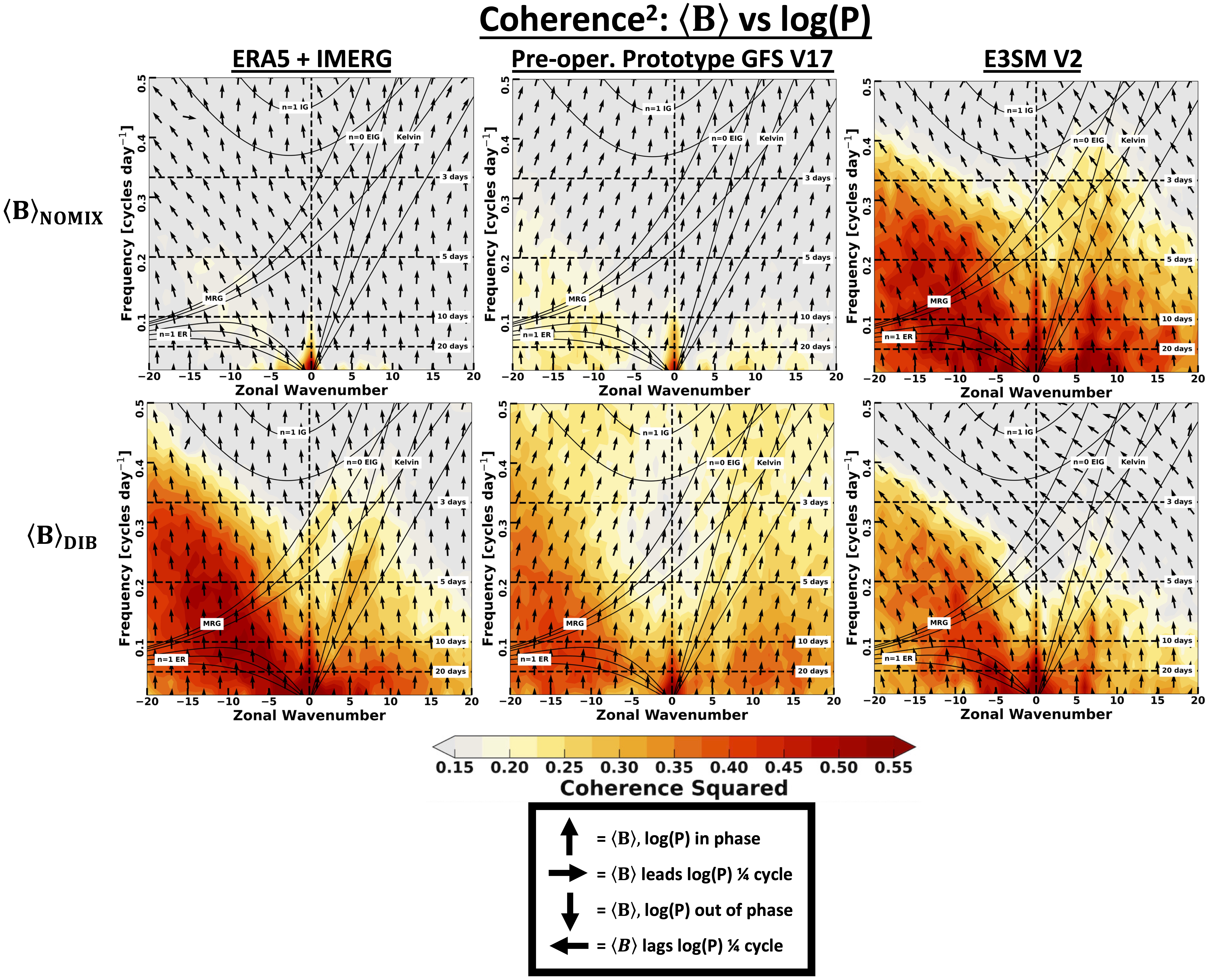
Color shading represents a measure of how precipitation and plume model buoyancy co-vary in observations (left column), a prototype of the GFS V17 (middle column) and the E3SM V2 (right column). The top row highlights co-variability between precipitation and plume buoyancy when the cloud is not allowed to mix with its surrounding environment. The bottom row highlights co-variability between precipitation and plume buoyancy when the cloud is allowed to mix with its surrounding environment.
Diagnostics of Tropical Variability for Numerical Weather Forecasts
Numerical weather prediction (NWP) models struggle with representing the full range of scales of tropical convective phenomena. Improved skill in the representation of tropical larger-scale features such as convectively coupled equatorial waves (CCEWs) has the potential to reduce forecast error propagation from the tropics to the midlatitudes. We develop diagnostics that are able to assess model skill as a function of lead time and show their utility by applying them to two versions of NOAA’s Unified Forecast System (GFSv15 and GFSv16). The diagnostics are available to the community on GitHub.
More information in:
Gehne, M., B. Wolding, J. Dias, and G. N. Kiladis, 2022: Diagnostics of Tropical Variability for Numerical Weather Forecasts. Wea. Forecasting, 37, 1661–1680, https://doi.org/10.1175/WAF-D-21-0204.1

Symmetric space–time coherence spectra 15°S–15°N between (a) GFSv15 precipitation at FH06 (FH = forecast hour) and IMERG precipitation, (b) GFSv16 precipitation at FH06 and IMERG precipitation, (c) GFSv15 precipitation and divergence at 850 hPa (D850) at FH06, and (d) GFSv16 precipitation and D850 at FH06. Shading shows coherence squared, and arrows show the phase between the two variables. Difference of coherence squared at FH48 and coherence squared at FH06 is shown for (e) GFSv15 precipitation and IMERG precipitation, (f) GFSv16 precipitation and IMERG precipitation, (g) GFSv15 precipitation and D850, and (h) GFSv16 precipitation and D850.
A Data-Driven Approach to Identifying the Dynamical Modes of the Madden-Julian Oscillation
Accurately monitoring and understanding Madden-Julian Oscillation (MJO) variability is crucial for advancing subseasonal-to-seasonal (S2S) predictions and enhancing forecasting systems. To address this, a data-driven filter based on a linear inverse model (LIM) is developed to detect and characterize MJO variability and its links to El Niño-Southern Oscillation (ENSO). This approach represents tropical variability through non-orthonormal dynamical modes, capturing constructive and destructive interference patterns. Observed MJO variability arises from the interplay between a fast and a slow intraseasonal (20–96 days) atmospheric mode (“MJO-modes”), alongside SST-driven variability with similar spatial patterns (“ENSO-modes”). These insights provide a clearer understanding of the sources of predictive skill associated with tropical variability, ultimately improving forecasting capabilities.
MJO Research Team

George Kiladis
PSL | Visiting Scholar
Previous Contributors

Benjamin Moore
PSL Meteorologist (2018-2025)
Resources
| Tutorials and Monitoring | |
|---|---|
| What is the MJO and why do we care? | A short tutorial on the MJO from the Climate.gov ENSO blog. |
| MJO monitoring page | From NOAA/CPC. Includes various plots of the current status of the 30-60 day oscillation including OLR anomalies, geopotential height and other animations and satellite photos. Also includes a FAQ on the oscillation mechanism and evolution and its relationship to other climate processes. They also have a MJO daily index. |
| Wikipedia page on the MJO | Description, behavior, and connection to weather events. |
| World Climate Service: The Madden Julian Oscillation | Introduction, behavior and measurement. |
| All-season Real-time Multivariate MJO Index | Forecast and monitoring plots of the MJO that utilize and empirically derived structure of the MJO based on historic data and include predictions for Australia from the Australian Bureau of Meteorology. |
| Multi-Scale MJO Research Page | From Woods Hole Oceanographic Institution. The tropical Dynamics lab researches the MJO and how it interacts with waves and the mean state of the atmosphere/ocean. |
| PSL Spotlight Article on the MJO (August 2001) | The MJO and its effect on the onset of an El Niño event. |
| PSL Interactive Data Plotting and Weather/Climate Monitoring Pages | |
|---|---|
Plot Phase Diagrams using MJO Indices 
|
Choose from an MJO index to get a phase plot for an input range of dates. |
| Tropical Diagnostics Toolbox | GitHub repository of the Tropical Diagnostics Toolbox: Python scripts for diagnostics of convection in the Tropics in NWP forecasts developed at PSL. |
| Interactive MJO Composites | Choose MJO to get list of high/low MJO activity days. Use these days on the page daily composite page to obtain composites for different variables. |
| Time Section Plots | Plots time/latitude and time/longitude plots of NCEP reanalysis and operational data. Plots means and anomalies. |
| Plot Daily Data | Plots maps or crossections of daily and daily averaged data. Includes anomalies, means and climatologies. Includes OLR. |
| Related PSL Sites | |
|---|---|
| PSL Map Room | Includes maps of many variables for many different variables and time scales. Includes links to MJO Composites along with many other climate/weather variables. |
| El Niño/Southern Oscillation (ENSO) | Products, forecasts, and science related to ENSO |
| Tropical Pacific Precipitation and SST Forecast | Forecasts of tropical variables made using "Model Analogues" are provided. |
| Links to datasets used in PSL MJO Index Calculations | |
|---|---|
| NCEP/NCAR Reanalysis | NOAA's original global reanalysis starting from 1948 |
| ERA5 Reanalysis | The ECMWF high resolution modern reanalysis from 1940. |
Publications and References
Click on a panel below to view the publications from that year. Bold indicates PSL-affiliated author. All links are external
2025
- Bengtsson, L., Tulich, S. N., Dias, J., Wolding, B., Hall, K. J. C., Gehne, M., et al. (2025). The crucial role of the initial state in MJO prediction. Geophysical Research Letters, 52, e2025GL115833. https://doi.org/10.1029/2025GL115833
- Dias, J., Gehne, M., Kiladis, G. N., Wolding, B., & Hoell, A. (2025). Robust multi-decadal variability of Madden-Julian oscillation amplitude in the 20th century. Geophysical Research Letters, 52, e2024GL113303. https://doi.org/10.1029/2024GL113303
2024
- Wolding, B., A. Rydbeck, J. Dias, F. Ahmed, M. Gehne, G. N. Kiladis, et al. (January 2024): Atmosphere-Ocean Coupled Energetics of Shallow and Deep Tropical Convective Discharge-Recharge Cycles. J. Atmos. Sci., 81, 3-29, https://doi.org/10.1175/JAS-D-23-0061.1.
2023
- Rapid Development of Systematic ENSO-Related Seasonal Forecast Errors J. D. Beverley, M. Newman, A. Hoell. Geophysical Research Letters. May 2023.Vol 50. https://agupubs.onlinelibrary.wiley.com/doi/full/10.1029/2022GL102249
- Barpanda, P., S. N. Tulich, J. Dias and G. N. Kiladis (October 2023): The role of subtropical Rossby waves in amplifying the divergent circulation of the Madden Julian Oscillation. J. Atmos. Sci., 80, 2377–2398, https://doi.org/10.1175/JAS-D-22-0259.1.
- Klotzbach, P. J., C. J. Schreck III, G. P. Compo, et al. (April 2023): Influence of The Madden-Julian Oscillation on Continental United States Hurricane Landfalls . Geophys. Res. Lett., 50, e2023GL102762, https://doi.org/10.1029/2023gl102762.
- Dias, J., M. Gehne, G. N. Kiladis and L. Magnusson (November 2023): The role of convectively coupled equatorial waves in sub-seasonal predictions. Geophys. Res. Lett., 50, e2023GL106198, https://doi.org/10.1029/2023GL106198.
- Cheng, Y.-M., J. Dias, G. N. Kiladis, Z. Feng and L. R. Leung (May 2023): Mesoscale convective systems modulated by convectively coupled equatorial waves. Geophys. Res. Lett., 50, e2023GL103335, https://doi.org/10.1029/2023GL103335.
2022
- Amaya, D. J., M. G. Jacox, J. Dias, M. A. Alexander, K. Karnauskas, J. D. Scott and M. Gehne (January 2022): Subseasonal-to-seasonal forecast skill in the California Current System and its connection to coastal Kelvin waves. J. Geophys. Res. Oceans, 127 (1), e2021JC017892, https://doi.org/10.1029/2021JC017892..
- Bengtsson, L., L. Gerard, J. Han, M. Gehne, W. Li and J. Dias (December 2022): A Prognostic-Stochastic and Scale-Adaptive Cumulus Convection Closure for Improved Tropical Variability and Convective Gray-Zone Representation in NOAA’s Unified Forecast System (UFS). Mon. Wea. Rev., 150 (12), 3211–3227, https://doi.org/10.1175/MWR-D-22-0114.1.
- Berrington, A. H., N. Sakaeda, J. Dias and G. N. Kiladis (August 2022): Relationships Between the Eastward Propagation of the Madden-Julian Oscillation and its Circulation Structure. J. Geophys. Res. Atmos., 127 (16), e2021JD035806, https://doi.org/10.1029/2021JD035806.
- Cheng, Y.-M., S. N. Tulich, G. N. Kiladis and J. Dias (October 2022): Two extratropical pathways to forcing tropical convective disturbances. J. Climate, 35 (20), 2987–3009, https://doi.org/10.1175/JCLI-D-22-0171.1.
- Hsiao, W.-T., E. A. Barnes, E. D. Maloney, S. N. Tulich, J. Dias and G. N. Kiladis (March 2022): Role of the Tropics and its Extratropical Teleconnections in State-Dependent Improvements of U.S. West Coast UFS Precipitation Forecasts. Geophys. Res. Lett., 49 (5), e2021GL096447, https://doi.org/10.1029/2021GL096447.
- Knippertz, P., M. Gehne, G. N. Kiladis, K. Kikuchi, A. R. Satheesh, P. E. Roundy, G.-Y. Yang, J. Dias, A. H. Fink, J. Methven, A. Schlueter, F. Sielmann and M. C. Wheeler (July 2022): The intricacies of identifying equatorial waves. Q. J. R. Meteorol. Soc., 148 (747), 2814-2852, https://doi.org/10.1002/qj.4338.
- Wang, S., Z. K. Martin, A. H. Sobel, M. K. Tippett, J. Dias and G. N. Kiladis (February 2022): A multivariate index for tropical intraseasonal oscillations based on seasonally-varying modal structures. J. Geophys. Res. Atmos., 127 (4), e2021JD035961, https://doi.org/10.1029/2021JD035961.
- Wolding, B., S. W. Powell, F. Ahmed, J. Dias, M. Gehne, G. N. Kiladis and J. D. Neelin (July 2022): Tropical Thermodynamic–Convection Coupling in Observations and Reanalyses. J. Atmos. Sci., 79 (7), 1781–1803, https://doi.org/10.1175/JAS-D-21-0256.1.
2021
- Dias, J., S. N. Tulich, M. Gehne and G. N. Kiladis(September 2021): Tropical Origins of Weeks 2–4 Forecast Errors during the Northern Hemisphere Cool Season. Mon. Wea. Rev., 149 (9), 2975–2991, https://doi.org/10.1175/MWR-D-21-0020.1.
- Gehne, M., B. Wolding, J. Dias and G. N. Kiladis (September 2021): Diagnostics of Tropical Variability for Numerical Weather Forecasts. Wea. Forecasting, 37 (9), 1661–1680, https://doi.org/10.1175/WAF-D-21-0204.1.
- Haynes, P., P. Hitchcock, M. Hitchman, S. Yoden, H. H. Hendon, G. N. Kiladis, K. Kodera and I. Simpson (August 2021): The Influence of the Stratosphere on the Tropical Troposphere. J. Meteor. Soc. Japan, 99 (4), 803-845, https://doi.org/10.2151/jmsj.2021-040.
- Hoffmann, C. G., G. N. Kiladis, M. Gehne and C. von Savigny (May 2021): A Python Package to Calculate the OLR-Based Index of the Madden- Julian-Oscillation (OMI) in Climate Science and Weather Forecasting. J. Open Res. Software, 9 (1), 9, https://doi.org/10.5334/jors.331.
- Tulich, S. N. and G. N. Kiladis (September 2021): On the Regionality of Moist Kelvin Waves and the MJO: The Critical Role of the Background Zonal Flow. J. Adv. Model. Earth Syst., 13 (9), e2021MS002528, https://doi.org/10.1029/2021MS002528.
2011-2020
2020
- Sakaeda, N., J. Dias and G. N. Kiladis (September 2020): The unique characteristics and potential mechanisms of the MJO-QBO relationship. J. Geophys. Res. Atmos., 125 (17), e2020JD033196, https://doi.org/10.1029/2020JD033196.
- Wolding, B., J. Dias, G. N. Kiladis, E. Maloney and M. Branson (May 2020): Interactions between Moisture and Tropical Convection. Part II: The Convective Coupling of Equatorial Waves . J. Atmos. Sci., 77 (5), 1801-1819, https://doi.org/10.1175/JAS-D-19-0226.1.
- Wolding, B., J. Dias, G. N. Kiladis, F. Ahmed, S. W. Powell, E. Maloney and M. Branson (May 2020): Interactions between Moisture and Tropical Convection. Part I: The Coevolution of Moisture and Convection. J. Atmos. Sci., 77 (5), 1783-1799, https://doi.org/10.1175/JAS-D-19-0225.1.
2019
- Camberlin, P., W. Gitau, G. N. Kiladis, E. Bosire and B. Pohl (November 2019): Intraseasonal to Interannual Modulation of Diurnal Precipitation Distribution Over Eastern Africa. J. Geophys. Res. Atmos., 124 (22), 11863-11886, https://doi.org/10.1029/2019JD031167.
- Dias, J. and G. N. Kiladis (April 2019): The Influence of Tropical Forecast Errors on Higher Latitude Predictions. Geophys. Res. Lett., 46 (8), 4450-4459, https://doi.org/10.1029/2019GL082812.
2018
- Dias, J., M. Gehne, G. N. Kiladis, N. Sakaeda, P. Bechtold and T. Haiden (June 2018): Equatorial Waves and the Skill of NCEP and ECMWF Numerical Weather Prediction Systems. Mon. Wea. Rev., 146, 1763-1784, https://doi.org/10.1175/MWR-D-17-0362.1 .
- Hoell A. (November 2018): Middle East and Southwest Asia Daily Precipitation Characteristics Associated with the Madden–Julian Oscillation during Boreal Winter. J. Climate, 31, 8843-8860. doi:10.1175/JCLI-D-18-0059.1
- Capotondi A. and P. D. Sardeshmukh (October 2018): The Nature of the Stochastic Wind Forcing of ENSO. J. Climate, 31, 8081-8099. doi:10.1175/JCLI-D-17-0842.1
- Vera C. S., P. L. M. Gonzalez, B. Liebmann and G. N. Kiladis (November 2018): Seasonal cycle of precipitation variability in South America on intraseasonal timescales. Clim. Dyn., ONLINE, doi:10.1007/s00382-017-3994-1
- Kikuchi K., G. N. Kiladis, J. Dias and T. Nasuno (June 2018): Convectively coupled equatorial waves within the MJO during CINDY/DYNAMO: slow Kelvin waves as building blocks. Clim. Dyn., doi:10.1007/s00382-017-3869-5
- Sakaeda N., S. W. Powell, J. Dias and G. N. Kiladis (April 2018): The Diurnal Variability of Precipitating Cloud Populations during DYNAMO. J. Atmos. Sci., 75, 1307-1326. doi:10.1175/JAS-D-17-0312.1
2017
- Alvarez M. S., C. S. Vera and G. N. Kiladis (November 2017): MJO Modulating the Activity of the Leading Mode of Intraseasonal Variability in South America. Atmosphere, 8 (12), p. 232. doi:10.3390/atmos8120232
- Dias J., N. Sakaeda, G. N. Kiladis and K. Kikuchi (August 2017): Influences of the MJO on the space-time organization of tropical convection. J. Geophys. Res. Atmos., 122 (15), 8012-8032. doi:10.1002/2017JD026526
- Sakaeda N., G. N. Kiladis and J. Dias (April 2017): The Diurnal Cycle of Tropical Cloudiness and Rainfall Associated with the Madden-Julian Oscillation. J. Climate, 145, 1401-1412. doi:10.1175/JCLI-D-16-0788.1
- Sossa A., B. Liebmann, I. Bladé, D. Allured, H. H. Hendon, P. Peterson and A. Hoell (March 2017): Statistical Connection between the Madden–Julian Oscillation and Large Daily Precipitation Events in West Africa. J. Climate, 30, 1999-2010. doi:10.1175/JCLI-D-16-0144.1
- Cannon F. , L. M. V. Carvalho, C. Jones, A. Hoell, J. Norris, G. N. Kiladis and A. A. Tahir (February 2017): The influence of tropical forcing on extreme winter precipitation in the western Himalaya. Clim. Dyn., 48 (3), 1213-1232. doi:10.1007/s00382-016-3137-0
2016
- Alvarez M. S., C. S. Vera, G. N. Kiladis and B. Liebmann (January 2016): Influence of the Madden Julian Oscillation on precipitation and surface air temperature in South America. Clim. Dyn., 46 (1), 245-262. doi:10.1007/s00382-015-2581-6.
- Cannon F. , L. M. V. Carvalho, C. Jones, A. Hoell, J. Norris, G. N. Kiladis and A. A. Tahir (April 2016): The influence of tropical forcing on extreme winter precipitation in the western Himalaya. Clim. Dyn., ONLINE, doi:10.1007/s00382-016-3137-0
- Valéds-Pineda R., J. B. Valdés, H. F. Diaz and R. Pizarro-Tapia (June 2016): Analysis of spatio-temporal changes in annual and seasonal precipitation variability in South America-Chile and related ocean-atmosphere circulation patterns. Int. J. Climatol., 36 (8), 2979-3001. doi:10.1002/joc.4532
- van der Linden R., A. H. Fink, J. G. Pinto, T. Phan-Van and G. N. Kiladis (August 2016): Modulation of Daily Rainfall in Southern Vietnam by the Madden–Julian Oscillation and Convectively Coupled Equatorial Waves. J. Climate, 29, 5801-5820. doi:10.1175/JCLI-D-15-0911.1
2015
- Chen S., M. Flatau, T. G. Jensen, T. Shinoda, J. Schmidt, P. May, J. Cummings, M. Liu, P. E. Ciesielski, C. W. Fairall, et al. (October 2015): A Study of CINDY/DYNAMO MJO Suppressed Phase. J. Atmos. Sci., 72, 3755-3779. doi:10.1175/JAS-D-13-0348.1
- de Szoeke S. P., J. B. Edson, J. R. Marion, C. W. Fairall and L. Bariteau (January 2015): The MJO and Air–Sea Interaction in TOGA COARE and DYNAMO. J. Climate, 28, 597-622. doi:10.1175/JCLI-D-14-00477.1
2014
- Moum J. N., S. P. de Szoeke, W. D. Smyth, J. B. Edson, H. L. DeWitt, A. J. Moulin, E. J. Thompson, C. J. Zappa, S. A. Rutledge, R. H. Johnson and C. W. Fairall (August 2014): Air–Sea Interactions from Westerly Wind Bursts During the November 2011 MJO in the Indian Ocean. Bull. Am. Meteorol. Soc., 95 (8), 1185-1199. doi:10.1175/BAMS-D-12-00225.1
- Kiladis G. N., J. Dias, K. H. Straub, M. C. Wheeler, S. N. Tulich, K. Kikuchi, K. M. Weickmann and M. J. Ventrice (May 2014): A Comparison of OLR and Circulation-Based Indices for Tracking the MJO. Mon. Weather Rev., 142 (5), 1697-1715. doi:10.1175/MWR-D-13-00301.1
- Hamill T. M. and G. N. Kiladis (February 2014): Skill of the MJO and Northern Hemispheric Blocking in GEFS Medium-Range Reforecasts. Mon. Weather Rev., 142 (2), 868-885. doi:10.1175/MWR-D-13-00199.1
2013
- Ventrice M. J., M. C. Wheeler, H. H. Hendon, C. J. Schreck III, C. D. Thorncroft and G. N. Kiladis (December 2013): A Modified Multivariate Madden–Julian Oscillation Index Using Velocity Potential. Mon. Weather Rev., 141 (12), 4197-4210. doi:10.1175/MWR-D-12-00327.1
- Dias J., S. Leroux, S. N. Tulich and G. N. Kiladis (April 2013): How systematic is organized tropical convection within the MJO? Geophys. Res. Lett., 40 (7), 1420-1425. doi:10.1002/grl.50308
2012
- Guan B., D. E. Waliser, N. P. Molotch, E. J. Fetzer and P. J. Neiman (February 2012): Does the Madden-Julian Oscillation influence wintertime atmospheric rivers and snowpack in the Sierra Nevada? Mon. Weather Rev ., 140, 325-345. doi:10.1175/MWR-D-11-00087.1 dx.doi.org/10.1175/MWR-D-11-00087.1
2011
- Riley E. , B. Mapes and S. Tulich (December 2011): Clouds associated with the Madden–Julian Oscillation: A new perspective from CloudSat. J. Atmos. Sci., 68, 3032-3051. doi:10.1175/JAS-D-11-030.1
2000-2010
2010
- Gottschalck J., . . . ., K. M. Weickmann, et al. (September 2010): A Framework for Assessing Operational Madden-Julian Oscillation Forecasts: A CLIVAR MJO Working Group Project. Bull. Am. Meteorol. Soc., 91 (9), 1247-1258. doi:10.1175/2010BAMS2816.1
- Serra Y. L., G. N. Kiladis and K. I. Hodges (September 2010): Tracking and Mean Structure of Easterly Waves over the Intra-Americas Sea. J. Climate, 23 (18), 4823-4840. doi:10.1175/2010JCLI3223.1
- Janicot S., F. Mounier, S. Gervois, B. Sultan and G. N. Kiladis (July 2010): The Dynamics of the West African Monsoon. Part V: The Detection and Role of the Dominant Modes of Convectively Coupled Equatorial Rossby Waves. J. Climate, 23 (14), 4005-4024. doi:10.1175/2010jcli3221.1
2009
- Kim D., K. R. Sperber, W. Stern, D. E. Waliser, I.S. Kang, E. Maloney, W. Wang, K. M. Weickmann, J. Benedict, M. Khairoutdinov, M.-I. Lee, R. Neale, M. Suarez, K. Thayer-Calder and G. Zhang (December 2009): Application of MJO Simulation Diagnostics to Climate Models. J. Climate, 22 (23), 6413-6436. doi:10.1175/2009JCLI3063.1
- Lin J. L., T. Shinoda, B. Liebmann, T. Qian, W. Han, P. E. Roundy, J. Zhou and Y. Zheng (September 2009): Intraseasonal Variability Associated with Summer Precipitation over South America Simulated by 14 IPCC AR4 Coupled GCMs. Mon. Weather Rev., 137 (9), 2931-2954. doi:10.1175/2009MWR2777.1 https://dx.doi.org/10.1175/2009MWR2777.1
- Newman M., P. D. Sardeshmukh and M. C. Penland (June 2009): How Important Is Air-Sea Coupling in ENSO and MJO Evolution? J. Climate, 22 (11), 2958-2977. doi:10.1175/2008JCLI2659.1
- Waliser D. E., K. R. Sperber, . . . ., K. M. Weickmann and al. et (June 2009): MJO Simulation Diagnostics. J. Climate, 22 (11), 3006-3030. doi:10.1175/2008JCLI2731.1
- Weickmann K. and E. Berry (May 2009): The Tropical Madden-Julian Oscillation and the Global Wind Oscillation. Mon. Weather Rev., 137 (5), 1601-1614. doi:10.1175/2008MWR2686.1
- Janicot S., F. Mounier, N. M. Hall, S. Leroux, B. Sultan and G. N. Kiladis (March 2009): Dynamics of the West African Monsoon. Part IV: Analysis of 25-90-Day Variability of Convection and the Role of the Indian Monsoon. J. Climate, 22 (6), 1541-1565. doi:10.1175/2008JCLI2314.1
2008
- Lin J., B. E. Mapes, K. M. Weickmann, G. N. Kiladis, et al. (June 2008): North American Monsoon and Convectively Coupled Equatorial Waves Simulated by IPCC AR4 Coupled GCMs. J. Climate, 21 (12), 2919-2937. doi:10.1175/2007JCLI1815.1
- Shinoda T., P. E. Roundy and G. N. Kiladis (May 2008): Variability of Intraseasonal Kelvin Waves in the Equatorial Pacific Ocean. J. Phys. Oceanogr., 38 (5), 921-944. doi:10.1175/2007JPO3815.1
- Haertel P. T., G. Kiladis, A. Denno and T. M. Rickenbach (March 2008): Vertical-Mode Decompositions of 2-Day Waves and the Madden-Julian Oscillation. J. Atmos. Sci., 65 (3), 813-833. doi:10.1175/2007JAS2314.1
2007
- Sardeshmukh P. D. and P. Sura (December 2007): Multiscale Impacts of Variable Heating in Climate. J. Climate, 20 (23), 5677-5695. doi:10.1175/2007JCLI1411.1
- Weickmann K. and E. Berry (February 2007): A Synoptic-Dynamic Model of Subseasonal Atmospheric Variability. Mon. Weather Rev., 135 (2), 449-474. doi:10.1175/MWR3293.1
2006
- Kiladis, G. N. and B. E. Mapes (2006), Convective life cycles and scale interactions in tropical waves, Dynamics of Atmospheres and Ocean, 42(1-4), 1-2, 10.1016/j.dynatmoce.2006.07.001.
- Straub K. H., G. N. Kiladis and P. E. Ciesielski (December 2006): The role of equatorial waves in the onset of the South China Sea summer monsoon and the demise of El Niño during 1998. Dyn. Atmos. Oceans, 42 (1-4), doi:10.1016/j.dynatmoce.2006.02.005
- Roundy P. E. and G. N. Kiladis (October 2006): Observed relationships between oceanic Kelvin waves and atmospheric forcing. J. Climate, 19 (20), 5253-5272. doi:10.1175/JCLI3893.1
- Lin J., G. N. Kiladis, B. Mapes, K. M. Weickmann, K. R. Sperber, W. Lin, M. C. Wheeler, S. Schubert, A. Del Genio, L. J. Donner, S. Emori, J.-F. Gueremy, F. Hourdin, P. J. Rasch, E. Roeckner and J. F. Scinocca (June 2006): Tropical Intraseasonal Variability in 14 IPCC AR4 Climate Models. Part I: Convective Signals. J. Climate, 19 (12), 2665-2690. doi:10.1175/JCLI3735.1
2005
- Kiladis, G. N., K. Straub and P. Haertel (2005), Zonal and vertical structure of the Madden-Julian oscillation, J. Atmospheric Sciences, 62(8), 2790-2809, 10.1175/JAS3520.1..
- Lin J.-L., M. Zhang and B. Mapes (July 2005): Zonal Momentum Budget of the Madden-Julian Oscillation: The Source and Strength of Equivalent Linear Damping. J. Atmos. Sci., 62 (7), 2172-2188. doi:10.1175/JAS3471.1
2004
- Carvalho, L., C Jones and B. Liebmann (2004), The South Atlantic convergence zone: Intensity, form, persistence, and relationships with intraseasonal to interannual activity and extreme rainfall, Journal of Climate, 17(1), 88-108, 10.1175/1520-0442%282004%29017%3C0088:TSACZI%3E2.0.CO;2.
- Liebmann, B., G. N. Kiladis, C. Vera, A. Saulo and L. Carvalho (2004), Subseasonal variations of rainfall in South America in the vicinity of the low-level jet east of the Andes and comparison to those in the South Atlantic convergence zone, Journal of Climate, 17(19), 3829-3842, 10.1175/1520-0442%282004%29017%3C3829:SVORIS%3E2.0.CO;2.
- Lin, J. L., B. E. Mapes, M. Zhang and M. Newman (2004), Stratiform precipitation, vertical heating profiles, and the Madden-Julian oscillation, J. Atmospheric Sciences, 61(3), 296-309, 10.1175/1520-0469%282004%29061%3C0296:SPVHPA%3E2.0.CO;2.
2003
- Lin, J., B. Mapes, M. Zhang, and M. Newman, 2003: Stratiform precipitation, vertical heating profiles, and the Madden-Julian Oscillation. J. Atmos. Sci., in press.
2002
- Shinoda, T., and H. H. Hendon, 2002: Rectified wind forcing and latent heat flux produced by the Madden-Julian oscillation. J. Climate., 15, 3500-3508. [Abstract]
2001
- Shinoda, T., and H. H. Hendon, 2001: Upper ocean heat budget in response to the Madden-Julian Oscillation in the western equatorial Pacific. J. Climate, 14, 4147-4165. [Abstract]
- Lee, M.-I., I.-S. Kang, J.-K. Kim, and B. E. Mapes, 2001: Influence of cloud-radiation interaction on simulating tropical intraseasonal oscillation with an atmospheric general circulation model. J. Geophys. Res., 106, 14,219-14,233. [Abstract]
2000
- Hendon, H. H., B. Liebmann, M. E. Newman, J. D. Glick, and J. E. Schemm, 2000: Medium range forecast errors associated with active episodes of the Madden-Julian oscillation. Mon. Wea. Rev., 128, 69-86. [Abstract]
Pre-2000
1999
- Hendon, H. H., C. Zhang, and J. D. Glick, 1999: Interannual variation of the Madden-Julian oscillation during austral summer. J. Climate, 12, 2538-2550. [Abstract]
1998
- Hendon, H. H., B. Liebmann, and J. D. Glick, 1998: Oceanic Kelvin waves and the Madden-Julian oscillation. J. Atmos. Sci., 55, 88-101. [Abstract]
1997
- Weickmann, K. M., G. N. Kiladis, and P. D. Sardeshmukh, 1997: The dynamics of intraseasonal atmospheric angular momentum oscillations.J. Atmos. Sci., 54, 1445-1461. [Abstract]
- Zhang, C., and Hendon, H. H., 1997: On the propagating and standing components of the intraseasonal oscillation in tropical convection. J. Atmos. Sci., 54, 741-752. [Abstract]
1995
- Hendon, H. H., 1995: Length of day fluctuations associated with the Madden Julian oscillation. J. Atmos. Sci., 52, 2373-2383. [Abstract]
1994
- Weickmann, K., and P. Sardeshmukh, 1994: The atmospheric angular momentum budget associated with a Madden-Julian oscillation. J. Atmos. Sci., 51, 3194-3208. [Abstract]
- Hendon, H. H., and B. Liebmann, 1994: Organization of convection within the Madden-Julian Oscillation. J. Geophys. Res., 99, 8073-8083. [Abstract]
- Liebmann, B., H. H. Hendon, and J. D. Glick, 1994: The relationship between tropical cyclones of the western Pacific and Indian oceans and the Madden-Julian oscillation. J. Meteor. Soc. Japan, 72, 401-412. [Abstract]
Other MJO References
- Aiyyer, A. R., and Molinari, J. (2003). Evolution of mixed rossby-gravity waves in idealized MJO environments. J. Atmospheric Sciences, 60(23), 2837-2855.
- Aiyyer, A., and Molinari, J. (2002). Evolution of mixed rossby gravity waves in MJO type environments. 45 Beacon St. Boston MA 02108-3693 USA, https://www.ametsoc.org American Meteorological Society.
- Bannister, A. J., and Smith, K. J. (1993). The south pacific and southeast indian ocean tropical cyclone season 1990-91. Australian Meteorological Magazine, Canberra, Australia, 42(4), 175-182.
- Batstone, C., Matthews, A., and Stevens, D. (2002). Surface heat fluxes during the MJO and their effects on the oceanic mixed layer in the tropical eastern hemisphere. 45 Beacon St. Boston MA 02108-3693 USA, https://www.ametsoc.org American Meteorological Society.
- Bergman, J. W., Hendon, H. H., and Weickmann, K. M. (2001). Intraseasonal air-sea interactions at the onset of el nino. Journal of Climate, 14(8), 1702-1719.
- Bergman, J. W., Hendon, H. H., and Weickmann, K. M. (2001). Intraseasonal air-sea interactions at the onset of el nino. Journal of Climate, Boston, MA, 14(8), 1702-1719.
- Blade, I., and Hartmann, D. L. (1995). The linear and nonlinear extratropical response of the atmosphere to tropical intraseasonal heating. J. Atmospheric Sciences, Boston, MA, 52(24), 4448-4471.
- Boer, G. J. (1995). Analyzed and forecast large-scale tropical divergent flow. Monthly Weather Review, Boston, MA, 123(12), 3539-3553.
- Bond, N. A., and Vecchi, G. A. (2003). The influence of the madden-julian oscillation on precipitation in oregon and washington. Weather and Forecasting, 18(4), 600-613.
- Bond, N., and Vecchi, G. (2003). The influence of the madden-julian oscillation (MJO) on the weather of alaska (2003 - 7POLARCLIM). 45 Beacon St. Boston MA 02108-3693 USA: American Meteorological Society. Retrieved July 12, 2004, from Meteorological and Geoastrophysical Abstracts database.
- Carvalho, L. M. V., Jones, C., and Liebmann, B. (2004). The south atlantic convergence zone: intensity, form, persistence, and relationships with intraseasonal to interannual activity and extreme rainfall. Journal of Climate, 17(1), 88-108.
- Castro Sr, C., and Cavalcanti, I. (2003). Intraseasonal modes of variability affecting the SACZ (2003 - 7ICSHMO). 45 Beacon St. Boston MA 02108-3693 USA: American Meteorological Society. Retrieved July 12, 2004, from Meteorological and Geoastrophysical Abstracts database.
- Chao, W. C., and Chen, B. (2001). The role of surface friction in tropical intraseasonal oscillation. Monthly Weather Review, 129(4), 896-904.
- Chao, W. C. (1995). A critique of wave-CISK as an explanation for the 40-50 day tropical intraseasonal oscillation. J. Meteorological Society of Japan, Tokyo, Japan, 73(3), 677-684.
- Chao, W. C., and Chen, B. (2001). The role of surface friction in tropical intraseasonal oscillation. Monthly Weather Review, Boston, MA, 129(4), 896-904.
- Chen, B., and Yanai, M. (2000). Comparison of the madden-julian oscillation (MJO) during the TOGA COARE IOP with a 15-year climatology. Journal of Geophysical Research, Washington, DC, 105(D2), 2139-2149.
- Chen, B., and Yanai, M. (1999; 1999). The madden-julian oscillation (MJO) observed during the TOGA-COARE intensive observing period. part III: A comparison with climatology. World Meteorological Organization, , 171-172.
- Chen, T., Yen, M., Pfaendtner, J., and Sud, Y. C. (1993). The vertical structure of diabatic heating associated with the madden-julian oscillation simulated by the goddard laboratory for atmospheres climate model. Journal of Geophysical Research, Washington, DC, 98(D5), 8801-8813.
- Clayson, C. A., Strahl, B., and Schrage, J. (2002). 2-3-day convective variability in the tropical western pacific. Monthly Weather Review, 130(3), 529-548.
- Colon, E., Lindesay, J., and Suarez, M. J. (2002). The impact of surface flux- and circulation-driven feedbacks on simulated madden-julian oscillations. Journal of Climate, 15(6), 624-641.
- Compo, G. P., Kiladis, G. N., and Webster, P. J. (1999; 1999). The relationship between east asian pressure surges and the madden-julian oscillation. World Meteorological Organization, , 173-174.
- Davidson, N., Adug, E., Hassan, W., Nguyen, P., and Prabowo, M. (2002). Diagnosis and prediction of some extreme rain events over southeast asia. 45 Beacon St. Boston MA 02108-3693 USA, https://www.ametsoc.org American Meteorological Society.
- de Laat, A. T. J., and Lelieveld, J. (2002). Interannual variability of the indian winter monsoon circulation and consequences for pollution levels. Journal of Geophysical Research.D.Atmospheres, 107(D24)
- De Lima Moscati, M. C., and Rao, V. B. (2001). Energetics of the summer circulation over south america. Annales Geophysicae, 19(1), 83-97.
- Dickinson, M., and Molinari, J. (2002). Mixed rossby-gravity waves and western pacific tropical cyclogenesis. part I: synoptic evolution. J. Atmospheric Sciences, 59(14), 2183-2196.
- Donald, A., Ribbe, J., Stone, R., Wheeler, M., Meinke, H., and Harris, G. et al. (2003). Using the real-time multivariate madden julian oscillation indices to predict rainfall in queensland (2003 - 7ICSHMO). 45 Beacon St. Boston MA 02108-3693 USA: American Meteorological Society. Retrieved July 12, 2004, from Meteorological and Geoastrophysical Abstracts database.
- Fasullo, J., and Webster, P. J. (2000). Atmospheric and surface variations during westerly wind bursts in the tropical western pacific. Quarterly J. Royal Meteorological Society, Berkshire, England, 126(564), 899-924.
- Feldstein, S. B. (1999). The atmospheric dynamics of intraseasonal length-of-day fluctuations during the austral winter. J. Atmospheric Sciences, Boston, MA, 56(17), 3043-3058.
- Ferreira, R. N., Schubert, W. H., and Hack, J. J. (1996). Dynamical aspects of twin tropical cyclones associated with the madden-julian oscillation. J. Atmospheric Sciences, Boston, MA, 53(7), 929-945.
- Fink, A. (1995; 1995). The physical causes for the variability of intraseasonal tropical convection fluctuations over the indo-pacific. Universitaet zu Koeln, , 118.
- Fink, A., and Speth, P. (1997). Some potential forcing mechanisms of the year-to-year variability of the tropical convection and its intraseasonal (25-70-day) variability. International Journal of Climatology, Chichester, UK, 17(14), 1513-1534.
- Flatau, M., and Flatau, P. (1999; 1999). Atmosphere ocean interactions in the equatorial perturbations. World Meteorological Organization, , 189-190.
- Flatau, M., Flatau, P., Rudnick, D., and Niiler, P. P. (1999; 1999). Intraseasonal oscillations and asian monsoon onset. World Meteorological Organization, , 163-164.
- Frederiksen, J. S. (2002). Genesis of intraseasonal oscillations and equatorial waves. J. Atmospheric Sciences, 59(19), 2761-2781.
- Fujiwara, M., Kita, K., and Ogawa, T. (1998). Stratosphere-troposphere exchange of ozone associated with the equatorial kelvin wave as observed with ozonesondes and rawinsondes. Journal of Geophysical Research, Washington, DC, 103(D15), 19173-19182.
- Grabowski, W. W. (2003). MJO-like coherent structures: sensitivity simulations using the cloud-resolving convection parameterization (CRCP). Journal of the Atmospheric Sciences, 60(6), 847-864.
- Grabowski, W. (2002). Cloud microphysics and the tropical climate: idealized aquaplanet simulations using the cloud-resolving convection parameterization (CRCP) (2002 - 11cldphy). 45 Beacon St. Boston MA 02108-3693 USA: American Meteorological Society. Retrieved July 12, 2004, from Meteorological and Geoastrophysical Abstracts database.
- Grabowski, W. (2002). MJO-like coherent structures in idealized aquaplanet simulations. 45 Beacon St. Boston MA 02108-3693 USA, [URL:https://www.ametsoc.org]: American Meteorological Society.
- Grabowski, W., and Moncrieff, M. (2002). Large-scale organization of tropical convection in idealized numerical simulations: impact of radiative processes (2002 - 11atrad). 45 Beacon St. Boston MA 02108-3693 USA: American Meteorological Society. Retrieved July 12, 2004, from Meteorological and Geoastrophysical Abstracts database.
- Grabowski, W., and Moncrieff, M. (2002). Large-scale organization of tropical convection in idealized numerical simulations: impact of radiative processes (2002 - 11atrad). 45 Beacon St. Boston MA 02108-3693 USA: American Meteorological Society. Retrieved July 12, 2004, from Meteorological and Geoastrophysical Abstracts database.
- Gualdi, S., Navarra, A., and Tinarelli, G. (1999). The interannual variability of the madden-julian oscillation in an ensemble of GCM simulations. Climate Dynamics, Berlin, Germany, 15(9), 643-658.
- Gualdi, S., Navarra, A., and von Storch, H. (1997). Tropical intraseasonal oscillation appearing in operational analyses and in a family of general circulation models. J. Atmospheric Sciences, Boston, MA, 54(9), 1185-1202.
- Gualdi, S., von Storch, H., and Navarra, A. (1995; 1995). Tropical intraseasonal oscillation appearing in operational analyses and in a family of general circulation models. Max-Planck-Institut fuer Meteorologie, , 38.
- Hall, J. D., Matthews, A. J., and Karoly, D. J. (2001). The modulation of tropical cyclone activity in the australian region by the madden-julian oscillation. Monthly Weather Review, 129(12), 2970-2982.
- Hall-McKim, E., Nolin, A., Lo, F., Serreze, M., and Clark, M. (2002). Frequency analysis of intraseasonal variations in the north american monsoon system. 45 Beacon St. Boston MA 02108-3693 USA: American Meteorological Society. Retrieved July 12, 2004, from Meteorological and Geoastrophysical Abstracts database.
- Han, W., Lawrence, D. M., and Webster, P. J. (2001). Dynamical response of equatorial indian ocean to intraseasonal winds: zonal flow. Geophysical Research Letters, 28(22), 4215-4218.
- Harris, K. A. (1999; 1999). Teleconnection patterns associated with the MJO: a shallow water model analysis. World Meteorological Organization, , 409-410.
- Hartmann, D. L., and Maloney, E. D. (2001). The madden-julian oscillation, barotropic dynamics, and north pacific tropical cyclone formation. part II: stochastic barotropic modeling. J. Atmospheric Sciences, 58(17), 2559-2570.
- Hartmann, D. L., Michelsen, M. L., and Klein, S. A. (1992). Seasonal variations of tropical intraseasonal oscillations: a 20-25-day oscillation in the western pacific. J. Atmospheric Sciences, Boston, MA, 49(14), 1277-1289.
- Hendon, H. H. (2000). Impact of air-sea coupling on the madden-julian oscillation in a general circulation model. J. Atmospheric Sciences, Boston, MA, 57(24), 3939-3952.
- Hendon, H. H. (1995). Length of day changes associated with the madden-julian oscillation. Journal of the Atmospheric Sciences, Boston, MA, 52(13), 2373-2383.
- Hendon, H. H., and Glick, J. (1997). Intraseasonal air-sea interaction in the tropical indian and pacific oceans. Journal of Climate, Boston, MA, 10(4), 647-661.
- Hendon, H. H., and Liebmann, B. (1994). Organization of convection within the madden-julian oscillation. Journal of Geophysical Research, Washington, DC, 99(D4), 8073-8083.
- Hendon, H. H., Liebmann, B., and Glick, J. D. (1998). Oceanic kelvin waves and the madden-julian oscillation. J. Atmospheric Sciences, Boston, MA, 55(1), 88-101.
- Hendon, H. H., Liebmann, B., Newman, M., Glick, J. D., and Schemm, J. E. (2000). Medium-range forecast errors associated with active episodes of the madden-julian oscillation. Monthly Weather Review, Boston, MA, 128(1), 69-86.
- Hendon, H. H., and Salby, M. L. (1996). Planetary-scale circulations forced by intraseasonal variations of observed convection. J. Atmospheric Sciences, Boston, MA, 53(12), 1751-1758.
- Hendon, H. H., and Salby, M. L. (1994). The life cycle of the madden-julian oscillation. Journal of the Atmospheric Sciences, Boston, MA, 51(15), 2225-2237.
- Hendon, H. H., Zhang, C., and Glick, J. D. (1999). Interannual variation of the madden-julian oscillation during austral summer. Journal of Climate, Boston, MA, 12(8), 2538-2550.
- Higgins, R. W., and Shi, W. (2001). Intercomparison of the principal modes of interannual and intraseasonal variability of the north american monsoon system. Journal of Climate, 14(3), 403-417.
- Higgins, R. W., and Shi, W. (2001). Intercomparison of the principal modes of interannual and intraseasonal variability of the north american monsoon system. Journal of Climate, Boston, MA, 14(3), 403-417.
- Hung, C. -., and Yanai, M. (2002). Factors contributing to the onset of the australian summer monsoon. 45 Beacon St. Boston MA 02108-3693 USA, https://www.ametsoc.org American Meteorological Society.
- Johnson, R. H., Ciesielski, P. E., and Cotturone, J. A. (2001). Multiscale variability of the atmospheric mixed layer over the western pacific warm pool. J. Atmospheric Sciences, 58(18), 2729-2750.
- Jones, C., Carvalho, L. M. V., Wayne Higgins, R., Waliser, D. E., and Schemm, J. E. (2004). Climatology of tropical intraseasonal convective anomalies: 1979-2002. Journal of Climate, 17(3), 523-539.
- Jones, C., Carvalho, L., Higgins, W., Waliser, D., and Schemm, J. -. (2003). Variability of tropical intraseasonal convective anomalies (2003 - 14GLOBAL). 45 Beacon St. Boston MA 02108-3693 USA: American Meteorological Society. Retrieved July 12, 2004, from Meteorological and Geoastrophysical Abstracts database.
- Jones, C., Waliser, D. E., Schemm, J. -. E., and Lau, W. K. M. (2000). Prediction skill of the madden and julian oscillation in dynamical extended range forecasts. Climate Dynamics, Berlin, Germany, 16(4), 273-289.
- Jones, C. (2000). Occurrence of extreme precipitation events in california and relationships with the madden-julian oscillation. Journal of Climate, Boston, MA, 13(20), 3576-3587.
- Jones, C., and Schemm, J. E. (2000). The influence of intraseasonal variations on medium- to extended-range weather forecasts over south america. Monthly Weather Review, Boston, MA, 128(2), 486-494.
- Jones, C., Waliser, D. E., and Gautier, C. (1998). The influence of the madden-julian oscillation on ocean surface heat fluxes and sea surface temperature. Journal of Climate, Boston, MA, 11(5), 1057-1072.
- Jones, C., and Weare, B. C. (1996). The role of low-level moisture convergence and ocean latent heat fluxes in the madden and julian oscillation: an observational analysis using ISCCP data and ECMWF analyses. Journal of Climate, Boston, MA, 9(12), 3086-3104.
- Kane, R. P. (2000). ENSO relationship with indian rainfall in different months. International Journal of Climatology, Chichester, UK, 20(7), 783-792.
- Kayano, M. T., and Kousky, V. E. (1999). Intraseasonal (30-60 day) variability in the global tropics: principal modes and their evolution. Tellus.Series A-B, Stockholm, Sweden, 51A(3), 373-386.
- Kemball-Cook, S. R., and Weare, B. C. (2001). The onset of convection in the madden-julian oscillation. Journal of Climate, Boston, MA, 14(5), 780-793.
- Kessler, W. S. (2001). EOF representations of the madden-julian oscillation and its connection with ENSO. Journal of Climate, 14(13), 3055-3061.
- Kessler, W. S., and Kleeman, R. (2000). Rectification of the madden-julian oscillation into the ENSO cycle. Journal of Climate, Boston, MA, 13(20), 3560-3575.
- Kessler, W. S., McPhaden, M. J., and Weickmann, K. M. (1995). Forcing of intraseasonal kelvin waves in the equatorial pacific. Journal of Geophysical Research, Washington, DC, 100(C6), 10613-10631.
- Kikuchi, K., and Takayabu, Y. N. (2003). Equatorial circumnavigation of moisture signal associated with the madden- julian oscillation (MJO) during boreal winter. J. Meteorological Society of Japan, 81(4), 851-869.
- Kiladis, G. (2003). Ocean-atmosphere interaction within equatorially trapped atmospheric waves (2003 - 12ISA). 45 Beacon St. Boston MA 02108-3693 USA: American Meteorological Society. Retrieved July 12, 2004, from Meteorological and Geoastrophysical Abstracts database.
- Kiladis, G., and Revell, M. (2003). Modulation of southern hemisphere storm track activity by the madden-julian oscillation (2003 - 7ICSHMO). 45 Beacon St. Boston MA 02108-3693 USA: American Meteorological Society. Retrieved July 12, 2004, from Meteorological and Geoastrophysical Abstracts database.
- Kiladis, G., and Straub, K. (2003). Ocean-atmosphere interaction within equatorially trapped atmospheric waves (2003 - 12ISA). 45 Beacon St. Boston MA 02108-3693 USA: American Meteorological Society. Retrieved July 12, 2004, from Meteorological and Geoastrophysical Abstracts database.
- Krishnamurti, T. N., Chakraborty, D. R., Cubukcu, N., Stefanova, L., and Vijayakumar, T. S. V. (2003). A mechanism of the madden-julian oscillation based on interactions in the frequency domain. Quarterly J. Royal Meteorological Society, 129(593B), 2559-2590.
- Krishnan, R., and Venkatesan, C. (1997). Mechanisms of low frequency intraseasonal oscillations of the indian summer monsoon. Meteorology and Atmospheric Physics, Vienna, Austria, 62(1-2), 101-128.
- Lambert, S. J. (1990). Observed and simulated intraseasonal energetics. Journal of Climate, Boston, MA, 3(12 </STRONG> </PRE> </BODY> </HTML>), 1330-1346. Retrieved July 12, 2004, from Meteorological and Geoastrophysical Abstracts database.
- Lau, K. -., Li, X., and Wu, H. T. (2002). Evolution of the large scale circulation, cloud structure and regional water cycle associated with the south china sea monsoon during may-june, 1998. J. Meteorological Society of Japan, 80(5), 1129-1147.
- Lau, K. -., Sheu, P. -., and Kang, I. -. (1994). Multiscale low-frequency circulation modes in the global atmosphere. J. Atmospheric Sciences, Boston, MA, 51(9), 1169-1193.
- Lau, K. -., Sheu, P. J., Schubert, S., Ledvina, D., and Weng, H. (1996). Evolution of large-scale circulation during TOGA COARE: model intercomparison and basic features. Journal of Climate, Boston, MA, 9(5), 986-1003.
- Lau, K. -., and Sui, C. -. (1997). Mechanisms of short-term sea surface temperature regulation: observations during TOGA COARE. Journal of Climate, Boston, MA, 10(3), 465-472.
- Lau, K. -., and Wu, H. -. (1994). Large scale dynamics associated with super cloud cluster organization over the tropical western pacific. J. Meteorological Society of Japan, Tokyo, Japan, 72(4), 481-497.
- Lee, S. (1999). Why are the climatological zonal winds easterly in the equatorial upper troposphere? J. Atmospheric Sciences, Boston, MA, 56(10), 1353-1363.
- Li, W., Yu, R., and Zhang, X. (2001). Impacts of sea surface temperature in the tropical pacific on interannual variability of madden-julian oscillation in precipitation. Advances in Atmospheric Sciences, Beijing, China, 18(3), 429-444.
- Liebmann, B., Hendon, H. H., and Glick, J. D. (1994). The relationship between tropical cyclones of the western pacific and indian oceans and the madden-julian oscillation. J. Meteorological Society of Japan, Tokyo, Japan, 72(3), 401-412.
- Liess, S., Bengtsson, L., and Arpe, K. (2001). The madden-julian oscillation in the ECHAM4/OPYC3 CGCM (M2 551.581.1 Theoretical climatology. Climatic models. Solar climate (551.581.1); M2 551.465.7:551.5 No. 319) July 12, 2004, from Meteorological and Geoastrophysical Abstracts database.
- Lin, J. W., Neelin, J. D., and Zeng, N. (2000). Maintenance of tropical intraseasonal variability: impact of evaporation-wind feedback and midlatitude storms. J. Atmospheric Sciences, Boston, MA, 57(17), 2793-2823.
- Lin, J. W., Neelin, J. D., and Zeng, N. (1999; 1999). Maintenance of tropical intraseasonal variability in an intermediate-complexity atmospheric model. World Meteorological Organization, , 179-180.
- Lo, F., and Hendon, H. H. (2000). Empirical extended-range prediction of the madden-julian oscillation. Monthly Weather Review, Boston, MA, 128(7), 2528-2543.
- Maloney, E. D. (2002). An intraseasonal oscillation composite life cycle in the NCAR CCM3.6 with modified convection. Journal of Climate, 15(9), 964-982.
- Maloney, E. D., and Esbensen, S. K. (2003). The amplification of east pacific madden-julian oscillation convection and wind anomalies during june-november. Journal of Climate, 16(21), 3482-3497.
- Maloney, E. D., and Hartmann, D. L. (2001). The madden-julian oscillation, barotropic dynamics, and north pacific tropical cyclone formation. part I: observations. J. Atmospheric Sciences, 58(17), 2545-2558.
- Maloney, E. D., and Kiehl, J. T. (2002). Intraseasonal eastern pacific precipitation and SST variations in a GCM coupled to a slab ocean model. Journal of Climate, 15(21), 2989-3007.
- Maloney, E. D., and Kiehl, J. T. (2002). MJO-related SST variations over the tropical eastern pacific during northern hemisphere summer. Journal of Climate, 15(6), 675-689.
- Maloney, E. D., and Hartmann, D. L. (2000). Modulation of eastern north pacific hurricanes by the madden-julian oscillation. Journal of Climate, Boston, MA, 13(9), 1451-1460.
- Maloney, E. D., and Hartmann, D. L. (2000). Modulation of hurricane activity in the gulf of mexico by the madden-julian oscillation. Science, Washington, DC, 287(5460), 2002-2004.
- Maloney, E. D., and Hartmann, D. L. (1998). Frictional moisture convergence in a composite life cycle of the madden-julian oscillation. Journal of Climate, Boston, MA, 11(9), 2387-2403.
- Marcus, S. L., Dickey, J. O., and De Viron, O. (2001). Links between intraseasonal (extended MJO) and ENSO timescales: insights via geodetic and atmospheric analysis. Geophysical Research Letters, 28(18), 3465-3468.
- Marcus, S. L., Ghil, M., and Dickey, J. O. (1994). The extratropical 40-day oscillation in the UCLA general circulation model. part I: atmospheric angular momentum. J. Atmospheric Sciences, Boston, MA, 51(11), 1431-1446.
- Marshall, A., Alves, O., Hendon, H., and Karoly, D. (2003). Investigating the role of air-sea coupling on the madden julian oscillation (2003 - 7ICSHMO). 45 Beacon St. Boston MA 02108-3693 USA: American Meteorological Society. Retrieved July 12, 2004, from Meteorological and Geoastrophysical Abstracts database.
- Matthews, A. J. (2000). Propagation mechanisms for the madden-julian oscillation. Quarterly Journal of the Royal Meteorological Society, Berkshire, England, 126(569), 2637-2651.
- Matthews, A. J., Hoskins, B. J., Slingo, J. M., and Blackburn, M. (1996). Development of convection along the SPCZ within a madden-julian oscillation. Quarterly J. Royal Meteorological Society, Berkshire, England, 122(531), 669-688.
- Matthews, A. J., and Kiladis, G. N. (1999). The tropical-extratropical interaction between high-frequency transients and the madden-julian oscillation. Monthly Weather Review, Boston, MA, 127(5), 661-677.
- Matthews, A. J., and Lander, J. (1999). Physical and numerical contributions to the structure of kelvin wave-CISK modes in a spectral transform model. Journal of the Atmospheric Sciences, Boston, MA, 56(23), 4050-4058.
- Matthews, A. J., Slingo, J. M., Hoskins, B. J., and Inness, P. M. (1999). Fast and slow kelvin waves in the madden-julian oscillation of a GCM. Quarterly J. Royal Meteorological Society, Berkshire, England, 125(557), 1473-1498.
- Meehl, G. A., Kiladis, G. N., Weickmann, K. M., Wheeler, M., Gutzler, D. S., and Compo, G. P. (1996). Modulation of equatorial subseasonal convective episodes by tropical-extratropical interaction in the indian and pacific ocean regions. Journal of Geophysical Research, Washington, DC, 101(D10), 15033-15049.
- Meehl, G. A., Wheeler, M., and Washington, W. M. (1994). Low-frequency variability and CO sub(2) transient climate change. part 3: intermonthly and interannual variability. Climate Dynamics, Berlin, Germany, 10(6-7), 277-303.
- Miller, A. J., Zhou, S., and Yang, S. (2003). Relationship of the arctic and antarctic oscillations to the outgoing longwave radiation. Journal of Climate, 16(10), 1583-1592.
- Mo, K. C. (2000). Intraseasonal modulation of summer precipitation over north america. Monthly Weather Review, Boston, MA, 128(5), 1490-1505.
- Mo, K. C. (1999). Alternating wet and dry episodes over california and intraseasonal oscillations. Monthly Weather Review, Boston, MA, 127(12), 2759-2776.
- Molinari, J., Knight, D., Dickinson, M., Vollaro, D., and Skubis, S. (1997). Potential vorticity, easterly waves, and eastern pacific tropical cyclogenesis. Monthly Weather Review, Boston, MA, 125(10), 2699-2708.
- Molinari, J., and Vollaro, D. (2000). Planetary- and synoptic-scale influences on eastern pacific tropical cyclogenesis. Monthly Weather Review, Boston, MA, 128(9), 3296-3307.
- Moore, A. M., and Kleeman, R. (1999; 1999). Stochastic forcing of ENSO intraseasonal variability: implications for ENSO prediction and predictability. World Meteorological Organization, , 383-384.
- Moskowitz, B. M., and Bretherton, C. S. (2000). An analysis of frictional feedback on a moist equatorial kelvin mode. J. Atmospheric Sciences, Boston, MA, 57(13), 2188-2206.
- Myers, D. S., and Waliser, D. E. (2003). Three-dimensional water vapor and cloud variations associated with the madden-julian oscillation during northern hemisphere winter. Journal of Climate, 16(6), 929-950.
- Myers, D., and Waliser, D. (2003). Analysis of moisture variability associated with the madden julian oscillation during northern hemisphere winter (2003 - VARIH2O). 45 Beacon St. Boston MA 02108-3693 USA: American Meteorological Society. Retrieved July 12, 2004, from Meteorological and Geoastrophysical Abstracts database.
- Nakazawa, T. (2000). MJO and tropical cyclone activity during 1997/98 ENSO. Advances in Space Research, Oxford, England, 25(5), 953-958.
- Nakazawa, T. (1999; 1999). MJOAa key component in the atmosphere for triggering ENSO. World Meteorological Organization, , 165-166.
- Oouchi, K., and Yamasaki, M. (2001). An MJO-like gravity wave and superclusters simulated in a two-dimensional cumulus-scale-resolving model under a warm pool condition. J. Meteorological Society of Japan, 79(1), 201-218.
- Park, C., Suarez, M. J., and Schubert, S. D. (1995). Response of the zonally asymmetric flow to time-dependent tropical heating. J. Atmospheric Sciences, Boston, MA, 52(21), 3738-3756.
- Potemra, J. T., Hautala, S. L., Sprintall, J., and Pandoe, W. (2002). Interaction between the indonesian seas and the indian ocean in observations and numerical models. Journal of Physical Oceanography, 32(6), 1838-1854.
- Rajendran, K., Nanjundiah, R. S., and Srinivasan, J. (2002). The impact of surface hydrology on the simulation of tropical intraseasonal oscillation in NCAR (CCM2) atmospheric GCM. J. Meteorological Society of Japan, 80(6), 1357-1381.
- Raymond, D. J. (2001). A new model of the madden-julian oscillation. J. Atmospheric Sciences, 58(18), 2807-2819.
- Ren, B., and Huang, R. (2003). 30-60-day oscillations of convection and circulation associated with the thermal state of the western pacific warm pool during boreal summer. Advances in Atmospheric Sciences, 20(5), 781-793.
- Revell, M., and Renwick, J. (2003). Why was september 2001 to september 2002 a year of anomalously low pressures over the tasman sea? (2003 - 7ICSHMO). 45 Beacon St. Boston MA 02108-3693 USA: American Meteorological Society. Retrieved July 12, 2004, from Meteorological and Geoastrophysical Abstracts database.
- Reynolds, C., Gelaro, R., and Murphree, T. (1996). Observed and simulated northern hemisphere intraseasonal circulation anomalies and the influence of model bias. Monthly Weather Review, Boston, MA, 124(6), 1100-1118.
- Salby, M. L., Garcia, R. R., and Hendon, H. H. (1994). Planetary-scale circulations in the presence of climatological and wave-induced heating. J. Atmospheric Sciences, Boston, MA, 51(16), 2344-2367.
- Salby, M. L., and Hendon, H. H. (1994). Intraseasonal behavior of clouds, temperature, and motion in the tropics. J. Atmospheric Sciences, Boston, MA, 51(15), 2207-2224.
- Schmidt, F. (2000). On normal mode aided modelling: application to asian monsoon. Meteorology and Atmospheric Physics, Vienna, Austria, 73(3-4), 189-210.
- Schrage, J. M., Vincent, D. G., and Fink, A. H. (1999). Modulation of intraseasonal (25-70 day) processes by the superimposed ENSO cycle across the pacific basin. Meteorology and Atmospheric Physics, Vienna, Austria, 70(1-2), 15-27.
- Schubert, S. D., and Wu, M. L. (2001). Predictability of the 1997 and 1998 south asian summer monsoon low-level winds. Journal of Climate, 14(15), 3173-3191.
- Seo, K. -., and Kim, K. -. (2003). Propagation and initiation mechanisms of the madden-julian oscillation. Journal of Geophysical Research.D.Atmospheres, 108(D13)
- Sheaffer, J. (2002). Variability of MJO associated with ENSO and the QBO. 45 Beacon St. Boston MA 02108-3693 USA, https://www.ametsoc.org American Meteorological Society.
- Sheng, J. (1995). The madden-julian oscillation in the canadian climate centre general circulation model. Climate Dynamics, Berlin, Germany, 12(2), 125-140.
- Shinoda, T., and Hendon, H. H. (2002). Rectified wind forcing and latent heat flux produced by the madden-julian oscillation. Journal of Climate, 15(23), 3500-3508.
- Shinoda, T., and Hendon, H. H. (2001). Upper-ocean heat budget in response to the madden-julian oscillation in the western equatorial pacific. Journal of Climate, 14(21), 4147-4165.
- Shinoda, T., and Hendon, H. (1999; 1999). Modeling of intraseasonal variability in the tropical western pacific and indian oceans. World Meteorological Organization, , 187-188.
- Shinoda, T., Hendon, H. H., and Glick, J. (1998). Intraseasonal variability of surface fluxes and sea surface temperature in the tropical western pacific and indian oceans. Journal of Climate, Boston, MA, 11(7), 1685-1702.
- Slingo, J. M., Rowell, D. P., Sperber, K. R., and Nortley, F. (1999; 1999). On the predictability of the interannual behaviour of the madden-julian oscillation and its relationship to el nino. World Meteorological Organization, , 335-336.
- Slingo, J. M., Rowell, D. P., Sperber, K. R., and Nortley, F. (1999). On the predictability of the interannual behaviour of the madden-julian oscillation and its relationship with el nino. Quarterly J. Royal Meteorological Society, Berkshire, England, 125(554), 583-609.
- Slingo, J. (1998). The 1997/98 el nino. Weather, Bracknell, England, 53(9), 274-281.
- Sobel, A. H., and Maloney, E. D. (2000). Effect of ENSO and the MJO on western north pacific tropical cyclones. Geophysical Research Letters, Washington, DC, 27(12), 1739-1742.
- Stephens, D., and Lamond, M. (2003). ENSO: the equator and the southern mid-latitudes must work together (2003 - 7ICSHMO). 45 Beacon St. Boston MA 02108-3693 USA: American Meteorological Society. Retrieved July 12, 2004, from Meteorological and Geoastrophysical Abstracts database.
- Teng, H., and Wang, B. (2003). Interannual variations of the boreal summer intraseasonal oscillation in the asian-pacific region. Journal of Climate, 16(22), 3572-3584.
- Tompkins, A., and Jung, T. (2002). Investigation of the MJO in the ECMWF model. 45 Beacon St. Boston MA 02108-3693 USA, https://www.ametsoc.org American Meteorological Society.
- Tung, W., and Yanai, M. (2002). Convective momentum transport observed during the TOGA COARE IOP. part 2. case studies. J. Atmospheric Sciences, 59(17), 2535-2549.
- Tung, W., and Yanai, M. (2002). Convective momentum transport observed during the TOGA COARE IOP. part I: general features. J. Atmospheric Sciences, 59(11), 1857-1871.
- Tung, W. -., and Yanai, M. (2002). Convective momentum transport observed during the TOGA COARE IOP: implications for parameterization. 45 Beacon St. Boston MA 02108-3693 USA, [URL:https://www.ametsoc.org]: American Meteorological Society.
- Tung, W. (1999; 1999). The madden-julian oscillation (MJO) observed during the TOGA-COARE intensive observing period. part II: convection associated with MJO. World Meteorological Organization, , 169-170.
- Vecchi, G. A., and Harrison, D. E. (1999; 1999). Large scale environmental associations with equatorial westerly wind events. World Meteorological Organization, , 387-388.
- Vincent, D. G., Fink, A., Schrage, J. M., and Speth, P. (1998). High- and low-frequency intraseasonal variance of OLR on annual and ENSO timescales. Journal of Climate, Boston, MA, 11(5), 968-986.
- Waliser, D. E., Lau, K. M., Stern, W., and Jones, C. (2003). Potential predictability of the madden-julian oscillation. Bulletin of the American Meteorological Society, 84(1), 33-50.
- Waliser, D. E., Murtugudde, R., and Lucas, L. E. (2003). Indo-pacific ocean response to atmospheric intraseasonal variability: 1. austral summer and the madden-julian oscillation. Journal of Geophysical Research.C.Oceans, 108(C5)
- Waliser, D. (2002). Potential predictability of the madden-julian oscillation. 45 Beacon St. Boston MA 02108-3693 USA: American Meteorological Society. Retrieved July 12, 2004, from Meteorological and Geoastrophysical Abstracts database.
- Waliser, D. (2002). Potential predictability of the madden-julian oscillation (2002 - observations). 45 Beacon St. Boston MA 02108-3693 USA: American Meteorological Society. Retrieved July 12, 2004, from Meteorological and Geoastrophysical Abstracts database.
- Waliser, D. E. (1996). Formation and limiting mechanisms for very high sea surface temperature: linking the dynamics and the thermodynamics. Journal of Climate, Boston, MA, 9(1), 161-188.
- Waliser, D. E., Jones, C., Schemm, J. E., and Graham, N. E. (1999; 1999). Extended-range tropical forecasts based on the slow evolution of the madden-julian oscillation. World Meteorological Organization, , 337-338.
- Waliser, D. E., Jones, C., Schemm, J. E., and Graham, N. E. (1999). A statistical extended-range tropical forecast model based on the slow evolution of the madden-julian oscillation. Journal of Climate, Boston, MA, 12(7), 1918-1939.
- Waliser, D. E., Lau, K. M., and Kim, J. (1999; 1999). The influence of coupled sea surface temperatures on the madden-julian oscillation: a model perturbation experiment. World Meteorological Organization, , 181-182.
- Waliser, D. E., Lau, K. M., and Kim, J. (1999). The influence of coupled sea surface temperatures on the madden-julian oscillation: a model perturbation experiment. J. Atmospheric Sciences, Boston, MA, 56(3), 333-358.
- Wang, B., and Xie, X. (1999; 1999). Impacts of the ocean-atmosphere interaction over the warm pool on MJO. World Meteorological Organization, , 177-178.
- Wang, B., and Xie, X. (1998). Coupled modes of the warm pool climate system. part I: the role of air-sea interaction in maintaining madden-julian oscillation. Journal of Climate, Boston, MA, 11(8), 2116-2135.
- Wang, W., Saha, S., and Kistler, R. (2003). MJO forecast with the NCEP MRF model: necessity of the inclusion of an interactive ocean (2003 - 12ISA). 45 Beacon St. Boston MA 02108-3693 USA: American Meteorological Society. Retrieved July 12, 2004, from Meteorological and Geoastrophysical Abstracts database.
- Wang, W., Saha, S., and Kistler, R. (2003). MJO forecast with the NCEP MRF model: necessity of the inclusion of an interactive ocean (2003 - 12ISA). 45 Beacon St. Boston MA 02108-3693 USA: American Meteorological Society. Retrieved July 12, 2004, from Meteorological and Geoastrophysical Abstracts database.
- Watterson, I. G. (2002). The sensitivity of subannual and intraseasonal tropical variability to model ocean mixed layer depth. Journal of Geophysical Research.D.Atmospheres, 107(D1-D2), [na].
- Weare, B. C. (2003). Composite singular value decomposition analysis of moisture variations associated with the madden-julian oscillation. Journal of Climate, 16(22), 3779-3792.
- Weare, B. (2003). Moisture variations associated with the initiation of madden-julian oscillation (2003 - 14GLOBAL). 45 Beacon St. Boston MA 02108-3693 USA: American Meteorological Society. Retrieved July 12, 2004, from Meteorological and Geoastrophysical Abstracts database.
- Weickmann, K. M. (1991). El Nino/Southern oscillation and madden-julian (30-60 day) oscillations during 1981-1982. Journal of Geophysical Research, Washington, DC, 96, 3187-3195.
- Wheeler, M., and Weickmann, K. M. (2001). Real-time monitoring and prediction of modes of coherent synoptic to intraseasonal tropical variability. Monthly Weather Review, 129(11), 2677-2694.
- Wheeler, M. (2003). The madden-julian oscillation and the java floods of January/February 2002 (2003 - 7ICSHMO). 45 Beacon St. Boston MA 02108-3693 USA: American Meteorological Society. Retrieved July 12, 2004, from Meteorological and Geoastrophysical Abstracts database.
- Woolnough, S., Slingo, J., and Hoskins, B. (1999; 1999). The relationship between convection and surface fluxes on intraseasonal timescales. World Meteorological Organization, , 183-184.
- Wu, M. L. C., Schubert, S., Kang, I., and Waliser, D. (2002). Forced and free intraseasonal variability over the south asian monsoon region simulated by 10 AGCMs. Journal of Climate, 15(20), 2862-2880.
- Yanai, M., and Chen, B. (1999; 1999). The madden-julian oscillation (MJO) observed during the TOGA-COARE intensive observing period. part I: global view. World Meteorological Organization, , 167-168.
- Yanai, M., Chen, B., and Tung, W. (2000). The madden-julian oscillation observed during the TOGA COARE IOP: global view. J. Atmospheric Sciences, Boston, MA, 57(15), 2374-2396.
- Zavala-Garay, J., Moore, A. M., Perez, C. L., and Kleeman, R. (2003). The response of a coupled model of ENSO to observed estimates of stochastic forcing. Journal of Climate, 16(17), 2827-2842.
- Zhang, C. (2001). Intraseasonal perturbations in sea surface temperatures of the equatorial eastern pacific and their association with the madden-julian oscillation. Journal of Climate, 14(6), 1309-1322.
- Zhang, C., and Anderson, S. P. (2003). Sensitivity of intraseasonal perturbations in SST to the structure of the MJO. J. Atmospheric Sciences, 60(17), 2196-2207.
- Zhang, C., and Gottschalck, J. (2002). SST anomalies of ENSO and the madden-julian oscillation in the equatorial pacific. Journal of Climate, 15(17), 2429-2445.
- Zhang, C. (2001). Intraseasonal perturbations in sea surface temperatures of the equatorial eastern pacific and their association with the madden-julian oscillation. Journal of Climate, Boston, MA, 14(6), 1309-1322.
- Zhang, C. (1999; 1999). Intraseasonal atmospheric surface forcing, oceanic responses, and SST feedback in the equatorial western pacific. World Meteorological Organization, , 175-176.
- Zhang, C. (1999; 1999). Variability of tropospheric water vapor and its effects on deep convection in the equatorial western pacific. World Meteorological Organization, , 415-416.
- Zhang, C. (1997). Intraseasonal variability of the upper-ocean thermal structure observed at 0 degree and 165 degree E. Journal of Climate, Boston, MA, 10(12), 3077-3092.
- Zhang, C., Hendon, H. H., Kessler, W. S., and Rosati, A. J. (2001). A workshop on the MJO and ENSO. Bulletin of the American Meteorological Society, 82(5), 971-976.
- Zhang, C., and Hendon, H. H. (1997). Propagating and standing components of the intraseasonal oscillation in tropical convection. J. Atmospheric Sciences, Boston, MA, 54(6), 741-752.
- Zhang, C., Hendon, H. H., Kessler, W. S., and Rosati, A. J. (2001). A workshop on the MJO and ENSO. Bulletin of the American Meteorological Society, Boston, MA, 82(5), 971-976.
- Zhang, C., and McPhaden, M. J. (2000). Intraseasonal surface cooling in the equatorial western pacific. Journal of Climate, Boston, MA, 13(13), 2261-2276.
- Zhang, G. J. (1999; 1999). The effects of westerly wind bursts and calm conditions on the air-sea fluxes during TOGA COARE. World Meteorological Organization, , 319-320.
- Zhang, S., Anderson, S., Plueddemann, A., and Weller, R. (1999; 1999). Large scale variability of surface heat flux and upper ocean response in the western pacific during COARE/IOP. World Meteorological Organization, , 251-252.
- Ziemke, J. R., and Chandra, S. (2003). A madden-julian oscillation in tropospheric ozone. Geophysical Research Letters, 30(23)
